
Maureen Meyer, Senior Associate
Gabriela Morales, Consultant
Washington Office on Latin America
June 2014

 | By Adam Isacson, Senior Associate Maureen Meyer, Senior Associate Gabriela Morales, Consultant Washington Office on Latin America June 2014 |
In February 2014, WOLA investigators paid a 12-day visit to several points along Mexico’s southern border with Guatemala. This visit was part of a larger project, begun in the second half of 2013, to monitor border security conditions, migration trends, and recent policy changes affecting this region.
Staff from WOLA’s Migration and Border Security Program have visited six sectors of Mexico’s 1,969-mile northern border with the United States since 2011, and we have reported from several of them. This is our first report on Mexico’s 714-mile southern border zone. It comes after several months of preparatory research—combing official documents, interviewing officials, and paying site visits—followed by our February research trip.
On this trip, we found a border very different from the U.S.-Mexico line. This one is simple to cross: with an ID card at an official entry point, by wading a river between towns, or by stepping over an invisible line in the backcountry. Starting in 2012, the number of U.S.-bound Central Americans making this first crossing—among them tens of thousands of unaccompanied children—began a surge that continues to intensify.
Once on the Mexican side, these migrants encounter a border security policy that is hard to define, at times contradictory, and unevenly implemented—but clearly toughening, often with U.S. backing.

Inner-tube rafts take people across the Suchiate River between Tecún Umán, Guatemala, and Ciudad Hidalgo, Mexico.
At the porous borderline, the buildup is mainly a halfhearted effort to keep better records of who is crossing. While circulation in the immediate border zone is free, Mexico’s border security tightens along the road network into the rest of the country and toward the United States. Roads and rivers are heavily policed, but not impermeable. Numerous security agencies with overlapping responsibilities coordinate poorly, suffer from endemic corruption, and manage to stop only a tiny fraction of U.S.-bound drugs.
The “belts of control,” Mexico’s scheme for securing the border inland from the borderline, have a notable exception: two lines of northbound cargo trains that, for reasons we did not hear explained clearly, are policed very lightly. For tens of thousands of yearly Central American migrants these trains, nicknamed “La Bestia” (The Beast), are the main option for getting across Mexico. The long ride atop the train is physically dangerous, and the lack of security leaves migrants at the mercy of Central American gangs, bandits, kidnappers, and corrupt officials. The stunning frequency of kidnapping, extortion, human trafficking, rape, and homicide puts Central American migrants’ plight in Mexico atop the list of the Western Hemisphere’s worst humanitarian emergencies.
The border security and migration situation is badly broken at Mexico’s southern border. But the way to fix it is not by aping the U.S. prescription of walls, patrols, soldiers, and technology. In a situation of low skills, poor coordination, and high impunity, beefing up existing border security will increase abuses and trigger more violence without actually reducing migrant flows or trafficking.
A better security approach for the Mexico-Guatemala border is clear, but politically difficult. The United States needs to approve a comprehensive immigration reform that sets clear rules for temporary work and pathways to citizenship. Mexico should adopt a special visa status or similar mechanism that allows migrants in transit who are victims of violence or abuse to go to the authorities without fear of deportation. Mexico’s judiciary and internal control agencies need dramatic improvements to stamp out corruption, the oxygen that sustains violent criminal groups. And Central American elites need to start protecting their citizens against gang violence and investing in education and job creation at home.
These recommendations, though, are either too heavy a political lift or will take a generation to implement. In the meantime, our report recommends several smaller steps that governments can take now—if not to solve, then at least to humanize border security and migration in the Mexico-Guatemala border zone. These include the following.
The U.S.-Mexico border gets far more attention in both countries' media and national capitals due to a spike in violence on Mexico’s side, an unprecedented security buildup on the U.S. side, and the intense U.S. debate over policies for dealing with cross-border migration. But this is changing. U.S. policymakers are increasingly concerned about Mexico’s southern border.
In 2013, for the first time, more than a third of migrants whom the U.S. Border Patrol apprehended were not Mexican. The overwhelming majority of these 153,055 “other-than-Mexican” apprehended migrants came from Central America, mainly El Salvador, Guatemala, and Honduras. The number of other-than-Mexican migrant apprehensions has nearly tripled in two years; there were 54,098 in 2011. (More apprehensions most likely means more migrants overall, though the number who avoid capture is unknown.)
The wave of Central American migrants has intensified. Eight months into the U.S. government’s 2014 fiscal year, which began in October 2013, Border Patrol had already apprehended 162,751 “other-than-Mexican” migrants, exceeding the full-year total for 2013.
Most of these Central American migrants begin their journey in the Mexico-Guatemala border zone, where they cross into Mexican territory for a long journey to the U.S. border. As a result, Mexico is also apprehending more Central American migrants within its territory. According to statistics from the Mexican Secretariat of the Interior’s (Secretaría de Gobernación, SEGOB) Migration Policy Unit, Mexico detained 86,298 foreign individuals in 2013. The Secretariat’s National Migration Institute (INM), the principal agency charged with enforcing migration law and protecting migrants, returned or deported 93 percent of those detained (80,079, a slight increase over the 79,416 people deported in 2012.) Of those deported in 2013, nearly all came from Honduras (32,800), Guatemala (30,005), or El Salvador (14,427). Data from the first four months of 2014 indicate an approximate 9 percent one-year jump in Mexico’s deportations of migrants from these three countries.
The states closest to Mexico’s southern border, and those along the shortest route between Central America and the United States, saw the most returns and deportations. Chiapas, which includes the most densely populated border zones, was in first place with 43 percent of the 2013 total (34,252), followed by Veracruz, Tabasco, and Oaxaca. The southern border region also hosted the greatest number of coordinated federal and state operations to apprehend and detain (or in INM terminology, “to rescue”) migrants.

Mexico apprehends most migrants in states that lie along the shortest path between Central America and the United States.
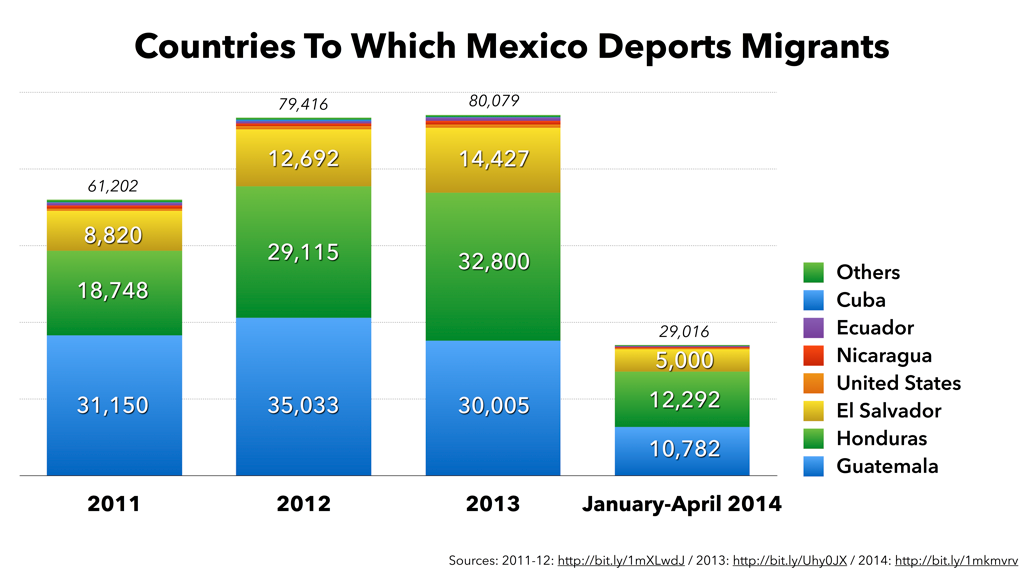
Three countries account for nearly all of Mexico’s growing number of migrant deportations. The number of Hondurans is on track to double between 2011 and 2014.
Between this rise in migration and a heavy presence of organized crime and trafficking groups, this region is receiving greater attention from Mexico—and the United States. It was not a central geographic focus in the first years of the “Mérida Initiative,” the framework that has guided nearly US$2 billion in U.S. security aid to Mexico since 2008. Starting in about 2011, however, U.S. officials began regularly declaring intentions to increase assistance to help both Mexico and Guatemala beef up their border security measures. That year, the U.S. Defense Department quietly launched a “Mexico-Guatemala-Belize Border Region Program,” providing as much as US$50 million for “patrol boats, night vision equipment, communications equipment, maritime sensors, and associated training” from the Pentagon’s counter-drug budget. “The Guatemalan border with Chiapas is now our southern border,” Assistant Secretary of Homeland Security for International Affairs Alan Bersin has said.
The United States was not alone in its focus on this border. Even before taking office in December 2012, advisors for Mexican President Enrique Peña Nieto were announcing his government’s plans to secure the country’s southern border. During the first months of Peña Nieto’s administration, Mexican officials repeatedly spoke of the need to increase a formal presence along the border. They placed border security as a priority topic in the Mexico-Guatemala bilateral agenda, and announced in June 2013 that the Mexican Marines would play a primary role on southern border security.
Peña Nieto has expressed interest in U.S. backing for a more concerted security effort in the southern border zone. What was once a smaller of the “four pillars” of the Mérida Initiative—“pillar 3,” or support to “create a 21st century border”—appears to be gaining momentum. Interviews with U.S. officials responsible for administering Mérida Initiative programs indicate that this is becoming the largest of the four pillars, measured in dollar terms, due to deliveries of expensive scanning equipment. Much of this new assistance will be delivered at Mexico’s southern—not just its northern—border.
A security buildup is underway at this border and promises to intensify. The surrounding region, which until quite recently did not attract much national or international attention, will be indelibly changed as a result.
The border line between Mexico and Guatemala often gets described as “porous.” We can attest to that. During our visit to the southern border zone, we crossed the line in four different places without showing our passports. At only two of those crossings did we interact with authorities from either government.
 Official border crossings: Mexico and Guatemala have ten official ports of entry. Eight are visible in this map, from north to south: El Ceibo, Tabasco; Frontera Corozal, Carmen Xhan, Ciudad Cuauhtémoc-Las Champas, Unión Juárez, Talismán, Suchiate II, and Ciudad Hidalgo, Chiapas.
Official border crossings: Mexico and Guatemala have ten official ports of entry. Eight are visible in this map, from north to south: El Ceibo, Tabasco; Frontera Corozal, Carmen Xhan, Ciudad Cuauhtémoc-Las Champas, Unión Juárez, Talismán, Suchiate II, and Ciudad Hidalgo, Chiapas. Train lines: There are two cargo train lines, one in the north running into Veracruz, and one in the south running to Oaxaca (and eventually to Veracruz). The southern line, damaged by a 2005 storm, begins today in Arriaga, Chiapas. Both lead eventually to Lechería, in Mexico state just north of Mexico City. Nationwide, the current cargo companies are Ferromex, Kansas City Southern de México, Ferrosur, Terminal y Ferrocaril del Valle de México, Línea Coahuila-Durango, Ferrocaril del Istmo, Ferrocarril CZRY, and Ferrocarriles Chiapas-Mayab, which operates near Mexico’s southern border.
Train lines: There are two cargo train lines, one in the north running into Veracruz, and one in the south running to Oaxaca (and eventually to Veracruz). The southern line, damaged by a 2005 storm, begins today in Arriaga, Chiapas. Both lead eventually to Lechería, in Mexico state just north of Mexico City. Nationwide, the current cargo companies are Ferromex, Kansas City Southern de México, Ferrosur, Terminal y Ferrocaril del Valle de México, Línea Coahuila-Durango, Ferrocaril del Istmo, Ferrocarril CZRY, and Ferrocarriles Chiapas-Mayab, which operates near Mexico’s southern border. “Belts of control”: Where the Mexican government proposes to concentrate checkpoints and other installations and activities to monitor the flow of goods and people.
“Belts of control”: Where the Mexican government proposes to concentrate checkpoints and other installations and activities to monitor the flow of goods and people. Principal migration routes.
Principal migration routes. Migrant shelters in Tapachula, Huixtla, Tenosique, Palenque, Arriaga, and possibly a new one in Comitán. A shelter operates on the Guatemalan side of the border in Tecún Umán.
Migrant shelters in Tapachula, Huixtla, Tenosique, Palenque, Arriaga, and possibly a new one in Comitán. A shelter operates on the Guatemalan side of the border in Tecún Umán. Newly built Customs facilities in Palenque, La Trinitaria, and Huixtla.
Newly built Customs facilities in Palenque, La Trinitaria, and Huixtla. Mexican Army Military Zone headquarters, roughly similar to brigades.
Mexican Army Military Zone headquarters, roughly similar to brigades. Mexican Navy Commands and “Advanced Naval Stations.”
Mexican Navy Commands and “Advanced Naval Stations.” Newly constructed Federal Police barracks in Tapachula. (Federal Police are deployed in smaller posts throughout Mexico’s border zone.)
Newly constructed Federal Police barracks in Tapachula. (Federal Police are deployed in smaller posts throughout Mexico’s border zone.)  Posts for Joint Task Force Tecún Umán, a U.S.-backed border security unit that combines personnel from Guatemala’s army, police, and prosecutors.
Posts for Joint Task Force Tecún Umán, a U.S.-backed border security unit that combines personnel from Guatemala’s army, police, and prosecutors.A key reason for the porosity is a lack of population density. Mexico’s southern border states account for less than 5 percent of its population, and Guatemala’s border states are about 20 percent. With the exception of the area around the Pacific coastal highway—which is near Mexico’s southernmost and Guatemala’s westernmost point—most of these states’ populations live far from the border area. The border is either a narrow river—the Suchiate in the southwest, the Usumacinta further north—or just a straight line over land that is often uninhabited and covered by dense vegetation.
As a result, crossing the border is trivially easy, and Mexico has chosen to focus its border security controls further from the line, in the border states’ interior.
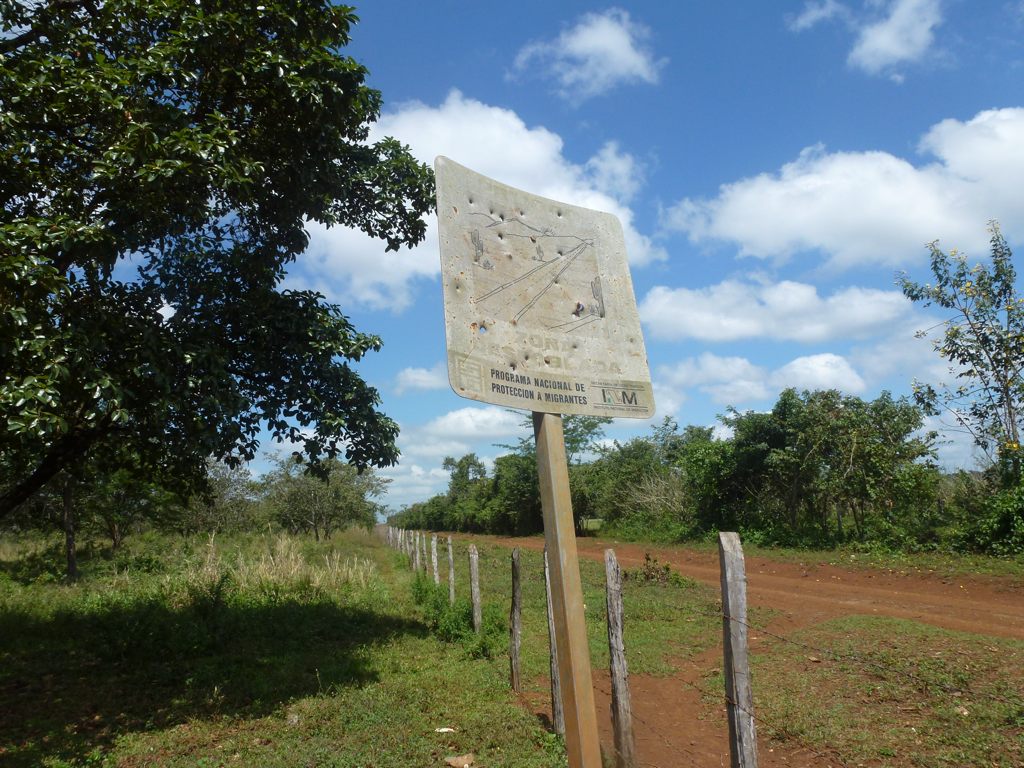
Looking across the land border into Petén, Guatemala from Tabasco, Mexico.
Guatemala’s border zone comprises the departments (provinces) of San Marcos, Huehuetenango, Quiché, Alta Verapaz, and Petén. This area was hit hard by the country’s 1960-1996 civil war. The Petén, Guatemala’s largest department, makes up a third of the national territory but only about 4 percent of its population.
On the Mexican side are the states of Chiapas, Tabasco, Campeche, and Quintana Roo. Chiapas has historically been Mexico’s most important point of entry, transit, and deportation. It was also where the Zapatista uprising burst onto the scene in 1994. Chiapas is an area of rugged mountains, with lowland jungles that are being converted, with remarkable rapidity, into cattle pastures, oil palm plantations, and other large-scale agriculture. In the eastern part of the state and into the central and northern highlands are numerous indigenous communities where, as in the Guatemalan highlands, many residents wear traditional dress, speak mostly Mayan dialects, and practice subsistence agriculture. The Mexican government’s response to the Zapatista uprising included a good deal of road construction in the conflict areas and regions where displaced Zapatista communities resettled, and it is relatively easy to get from place to place.
Chiapas’s coastal plain, known as the Soconusco region, is largely populated by mestizos (people of mixed indigenous and European heritage), most of them practicing agriculture and cattle ranching. The coast has numerous estuaries and mangrove swamps. The Soconusco region has stood out both for the quantity and diversity of its migrant population.
According to the most recent (2012) poverty statistics from Mexico’s National Council on the Evaluation of Social Development Policy (Consejo Nacional de la Evaluación de la Política de Desarrollo Social, CONEVAL), Chiapas is the state with the highest percentage of its population, 74.7 percent, living in poverty, as well as the highest percentage of its population living in extreme poverty, at 32.2 percent. Despite these dire numbers, Chiapas continues to be an option for residency for Central Americans, primarily from Guatemala, Honduras, and to a lesser extent, El Salvador.
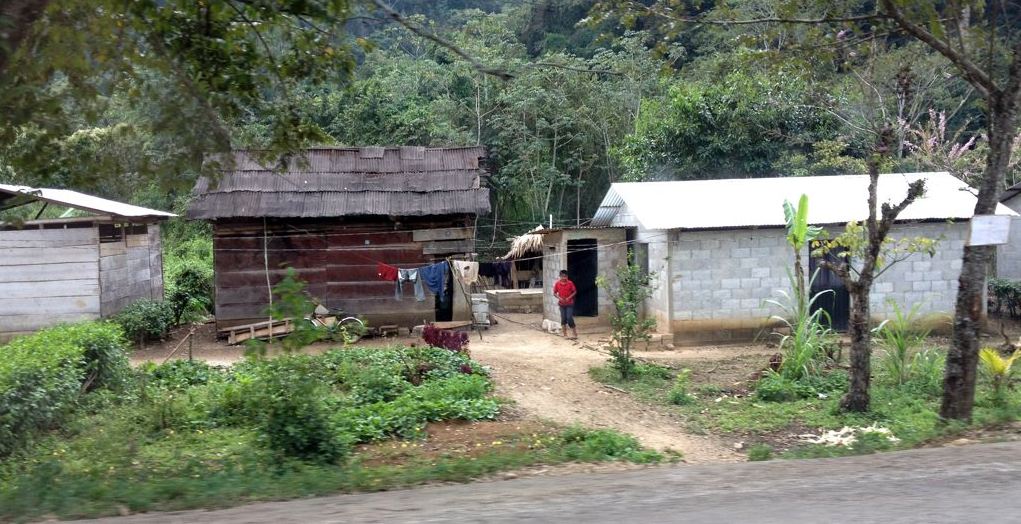
On the road near Palenque, Chiapas.
Migrants are principally Central American, though many arrivals come from Cuba, South America, Asia, the Middle East, and Africa. It is no coincidence that Latin America’s largest migrant detention center (which the INM calls a “migration station”) is located in the city of Tapachula, Chiapas, one of the principal entry points into Mexico.
Other nationalities also characterize the northernmost segment of the border, between the state of Quintana Roo and Belize. Migrants from Cuba work as service employees in the state’s tourist zones like Cancún, and recent years have seen a growing presence of Central Americans working in both the tourist industry and in agriculture, especially sugarcane cultivation. As a result, Quintana Roo is less a zone of migrant transit than a migrant destination. During Guatemala’s civil war, many citizens of that country passed through Quintana Roo, leaving children who are now part of Mexican families. The zone is also home to a community of Mennonites, many of whose children were born on the Belizean side but now live in Mexico. Their irregular citizenship status makes it difficult to receive basic services like education and health care.
Campeche and Tabasco, which border the sparsely populated Petén region, also have a largely Central American migrant population working in their agricultural sector, particularly cattle ranching and sugarcane. These states’ border regions, however, are swampy and support little labor-intensive agriculture. Instead they, especially Tabasco, are zones of transit where a rapidly growing number of Central American migrants begin their journey, mainly along the cargo train line discussed below.
The Mexico-Guatemala border region suffers high levels of illegal trafficking in drugs, people, weapons, and other contraband. However, except for occasional outbreaks, the region has mostly avoided the bloodshed that so often accompanies such organized illegal activity. The most notorious abuses of migrants, for instance, tend to happen further north.
Mexico’s southern border is far more tranquil than its U.S. borderlands, which in the past decade have witnessed some of the world’s highest levels of violent crime. According to the Executive Secretariat of Mexico’s National Public Security System (Secretariado Ejecutivo del Sistema Nacional de Seguridad Pública, SESNSP), the southern border states’ homicide rates are below the national average. Chiapas had the 12th lowest homicide rate of Mexico’s 31 states and Federal District in 2013, and Tabasco had the 6th lowest. State government billboards on Chiapas roadsides claim that it is the third safest state in the country.
Nonetheless, violence is a constant presence. As at Mexico’s northern border, gangs extort businesses, and assaults and property theft are common. Border communities have seen a troubling recent rise in the number of femicides—homicides of mostly young women—which jumped from 22 in 2010 to 97 in 2012. Migrant women are frequently the victims. In fact, much—probably most—violent crime against migrants goes unreported in official statistics, as the victims do not notify authorities for fear of being deported.
The Guatemalan side, too, tends to be less violent than the national average. Of the seven departments (out of twenty-two) with the lowest 2012 homicide rates, four were border departments. Only the agricultural frontier department of Petén—which has seen violent competition between traffickers linked to Mexico’s Zetas cartel, which is strongest in this part of the border zone—has a homicide rate above Guatemala’s national rate.
While it appears tranquil on the surface, this zone is receiving greater Mexican and U.S. government interest not only because of the surge of Central American migration, but because of its importance for the drug trade. The U.S. government estimates that as much as 80 percent of cocaine trafficked to the United States during the first half of 2013 passed through Guatemala, and the vast majority crossed the land border into Mexico.
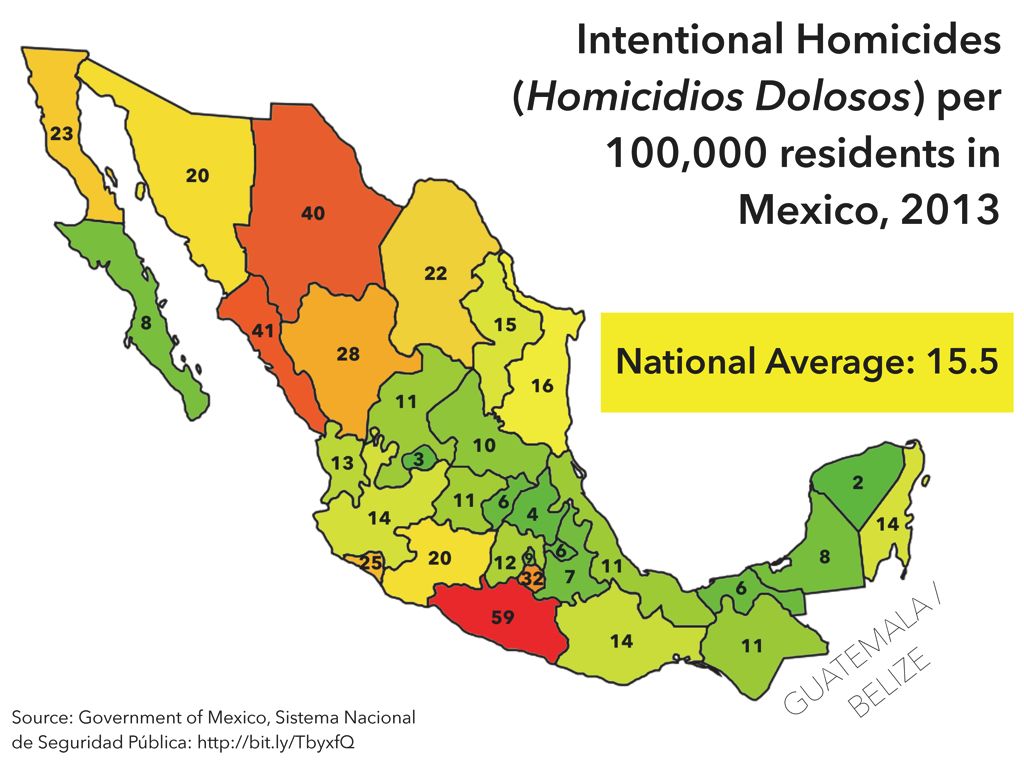 Homicide rates in Mexico’s southern border states are below the national average.
Homicide rates in Mexico’s southern border states are below the national average.
As on the U.S.-Mexico border, most southern border violence related to the drug trade happens on the southern (Guatemalan) side. This is likely because drugs spend some time on the Guatemalan side as they are staged for cross-border shipment, giving criminals a product to fight over, while they spend little time on the Mexican side of the border zone: they are moved north immediately.
Even Guatemalan drug-related violence has calmed recently in the border zone, as Mexico’s Sinaloa and Zetas cartels entered into separate, and probably temporary, arrangements with traditional Guatemalan drug-trafficking families. Violent outbreaks do occur, though: in June 2013 a killing of police officers in Salcajá, Quetzaltenango, was believed to be linked to an attempt by the Zetas, who are stronger in the eastern part of the border area, to operate in the Sinaloa cartel-dominated western zone.
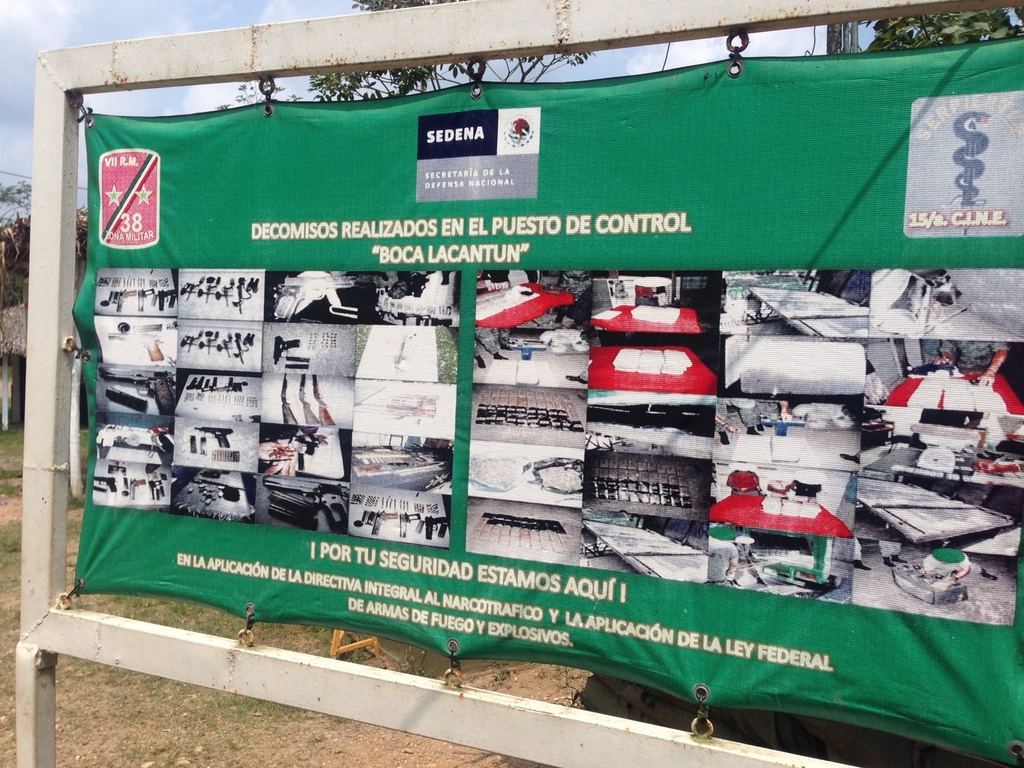
At an Army checkpoint near the Lacandón jungle in Chiapas, a sign displays past drug and arms seizures.
While transshipment is the main activity, some drug production takes place as well. In May 2011 Mexican authorities seized “an active methamphetamine clandestine laboratory” in Chiapas.
Little illicit money appears to stay in the area, though we did see some signs of hard-to-explain wealth. For instance in Frontera Comalapa, a small town about ten miles from the Guatemalan border, we saw many new trucks and other SUVs, often with young men driving inside and frequently without license plates.
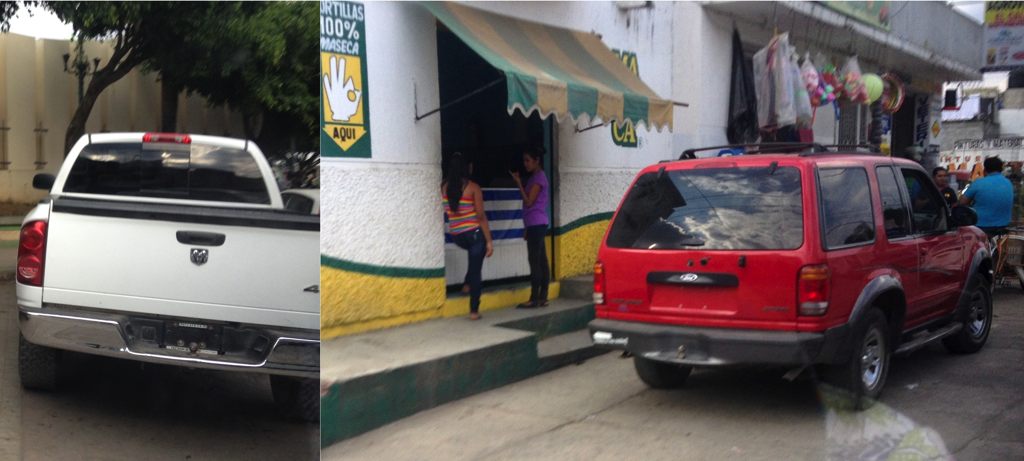
Trucks without plates in Frontera Comalapa.
In addition to drug transshipment concerns, U.S. officials view the border region as a possible conduit for extra-regional terrorists intent on infiltrating the United States. In Tapachula, the largest city in the border zone, the Homeland Security Investigations agency of U.S. Immigration and Customs Enforcement (ICE) reported in 2012 that it staffs an office “to build capacity in the identification of aliens from countries of national security concern who are released from the Tapachula detention facility.” To the extent we were able to determine, authorities have found no ties between international terrorist groups and any of the several dozen Asian, African, or Middle Eastern migrants detained each year in the Mexico-Guatemala border zone.
Human trafficking is another security problem linked to migration. A February 2014 study by the Observatorio Nacional Ciudadano stated that between 2010 and 2013, Chiapas had the second highest number of registered cases of human trafficking in Mexico, with the Federal District topping the list. A frequent phenomenon is young women, often minors, from Central America forced to work as prostitutes in border cities and unable to leave. Community leaders pointed out to us several bars as we drove through the border zone—often in very remote, rural towns—where this is a common phenomenon. The presence of trafficked women in these establishments appears to be an open secret, yet the authorities rarely act. A 2013 crackdown in Tapachula closed dozens of these bars, but at least half, local activists told us, reopened shortly afterward.
Although Chiapas is a relatively safe state, we heard accounts of communities organizing to respond to crime and as a way to protect themselves, with residents often preferring to address concerns within the community rather than calling in the police. There are indications that crime is increasing. We heard of roadblocks being set up by criminal groups charging fees to allow vehicles to pass, and of an increase in cases of extortion and kidnappings. These cases rarely appear in the local media. A May 2014 National Citizen Observatory (Observatorio Nacional Ciudadano, ONC) analysis of official crime data backs this sensation of insecurity. The study found that between 2012 and 2013, Chiapas registered an increase in complaints of four of the six high-impact crimes they monitored, with cases of extortion increasing by over 26 percent.

Rafts unload cargo, with no government officials present, on the Mexican side of the Suchiate River.
As would be expected of a sparsely populated zone, Mexico and Guatemala maintain only ten official border crossings. The Chiapas Border Police, a small force, claims that an additional 45 informal vehicle crossings exist between Chiapas and Guatemala. A 2010 State Department cable reports that in all, “only 125 Mexican immigration officials monitor the 577 mile border with Guatemala.”
In between the official crossings, the border is still easily traversed: the walls, sensors, and constant patrols that characterize the U.S.-Mexico border zone are absent here. Only in its remotest desert territories does the U.S.-Mexico border at all resemble the lack of fortification that characterizes most of the Mexico-Guatemala borderline.

Monuments mark the border on a hillside above Ciudad Cuauhtémoc, Mexico and La Mesilla, Guatemala.
In this context of apparently easy cross-border transit, Mexico’s strategy opts to extend border controls into the interior, and to involve various public security bodies, including the armed forces.
Authorities have been restructuring the official border crossings. Three ports of entry have been closed in Chiapas recently, and in several public forums and events since 2013, authorities have mentioned a likely further reduction. Currently, though, the INM and Mexico’s Foreign Relations Secretariat differ on the number of official ports of entry that exist along Mexico’s southern border.
For border residents, the line’s porosity is a generations-old tradition. Authorities try to keep a record of border crossings, but rarely seek to impede them. “Mexican law allows individuals to cross the border with an ‘original’ identification document but does not prescribe what constitutes an ‘original’ document,” notes a 2010 State Department cable. Residents and citizens of Guatemala and Belize are also able to enter Mexico as regional visitors, which allows them to be 100 kilometers north of the border in the states of Chiapas, Quintana Roo, Tabasco, and Campeche without obtaining a tourist visa.
In Chiapas’s border region, many Central American “migrants”—including those who show up in official government statistics of migrant detentions—have no intention of coming to the United States. They seek to remain in Mexico’s border area, engaging in commerce or seeking work. People come to buy and sell, and stores (including Wal-Mart) in Tapachula depend in part on the Guatemalan market. Guatemalans find cheap clothing in Mexico, while Mexicans find cheap gasoline in Guatemala.

Top: Big-box stores on Tapachula’s outskirts. Bottom: Mexican gasoline for sale at a roadside near Tecún Umán, Guatemala.
Some border crossers are migrant workers from Guatemala, who spend a few months in Mexico helping with the harvest on fincas and other large agribusinesses. This temporary migration flow dates back to the 19th century. Similar to the seasonal migration flows from poorer southern states like Guerrero to the fields in northern Mexico, Mexican citizens in the Soconusco region rarely deign to do seasonal work harvesting mangos, coffee, banana, papaya, sugarcane, and other products.
The cost of a temporary border work visa is approximately US$24. Enganchadores (recruiters) connect Guatemalan workers with Mexican farmers. Apart from these workers, those who cross the border for labor, shopping, or small-scale commerce generally do not bother to pass through the official crossings and their bureaucratic red tape.

Migrant workers await enganchadores in the main square of Tecún Umán, Guatemala.
In addition to agricultural labor, domestic household workers in the area are almost exclusively migrant women, mainly young Guatemalans. Other areas of migrant labor are informal or exploitative: young Guatemalan children who sell gum on the streets, workers in the municipal trash dump, and prostitutes, many of them human trafficking victims.
Because of their irregular status (with the exception of some who have temporary agricultural worker visas), migrant workers are often afraid to denounce any abuses they might suffer at the hands of their employers. Mexico’s new 2011 Migration Law also presents obstacles for migrants seeking to regularize their status in the country. For example, a temporary resident permit costs around US$250 for one year. For a migrant family struggling to make ends meet this cost can be prohibitive. It may also result in only the male head of household obtaining papers, increasing the vulnerability of his undocumented wife and making it unlikely that she would report any cases of domestic abuse should they occur.
While Mexico’s borderlands have a long tradition of migrants who settle there, the post-2011 influx of Central American arrivals consists mostly of people who intend to pass on to the United States. Mexican authorities and migrant shelters in the southern border zone are seeing increases in Central American migration similar to that recorded by U.S. authorities.
The first part of their trip is simple. Under the Central America-4 visa system, Guatemala, Honduras, El Salvador, and Nicaragua do not require each other’s citizens to present visas or passports. Needing only their identity cards, citizens of Honduras, El Salvador, and a much smaller number of Nicaraguans easily cross Guatemala to reach Mexico. Hondurans can take regular buses across the Petén and be at the Mexico border in less than 24 hours. Salvadorans cross Guatemala to Tapachula or to the Pan-American Highway crossing in Ciudad Cuauhtémoc. Then the real journey begins.
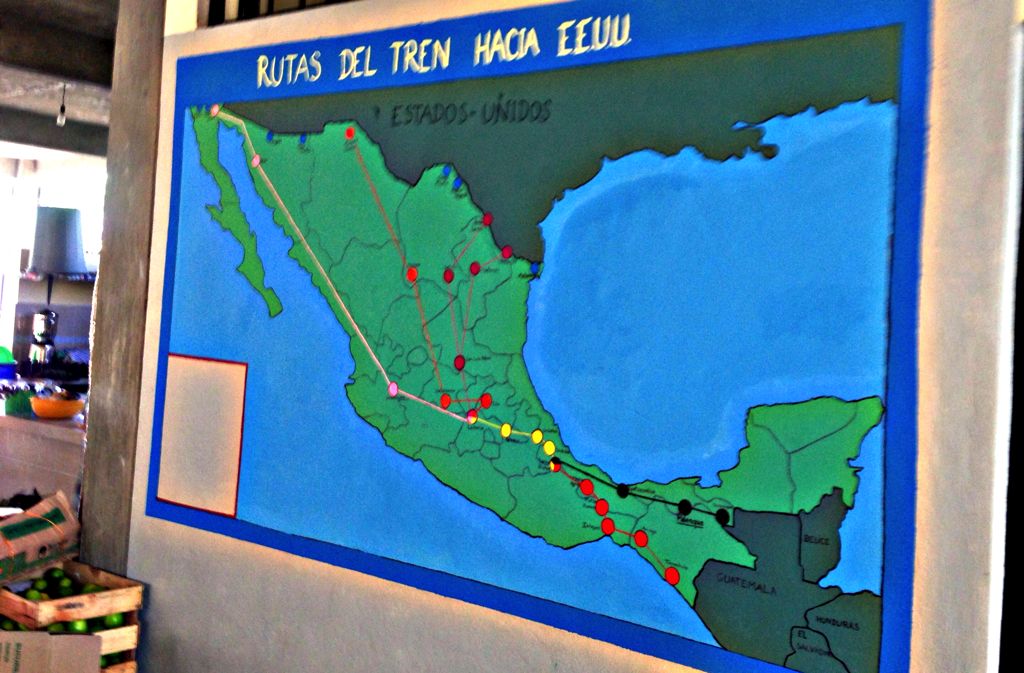
Train routes on migrant shelter wall, Palenque.
Migrants crossing at the southern border tend to pass through one of three corridors:
While poverty and limited economic opportunities continue to be the predominant factors in the migrants’ decision to leave their countries of origin, crime and violence have become an ever larger part of their calculation.
We visited the “La 72” migrant shelter in Tenosique, run by the Franciscan Catholic order; the “El Caminante” shelter in Palenque, run by Catholic nuns; and the “Hogar de la Misericordia” shelter, supported by the local Catholic Church in Arriaga. Staff at the facilities in Tenosique and Palenque, along the “jungle route,” told us that upwards of 90 percent of those arriving in their very full shelters had come from Honduras, even though Guatemala is just a few miles away.
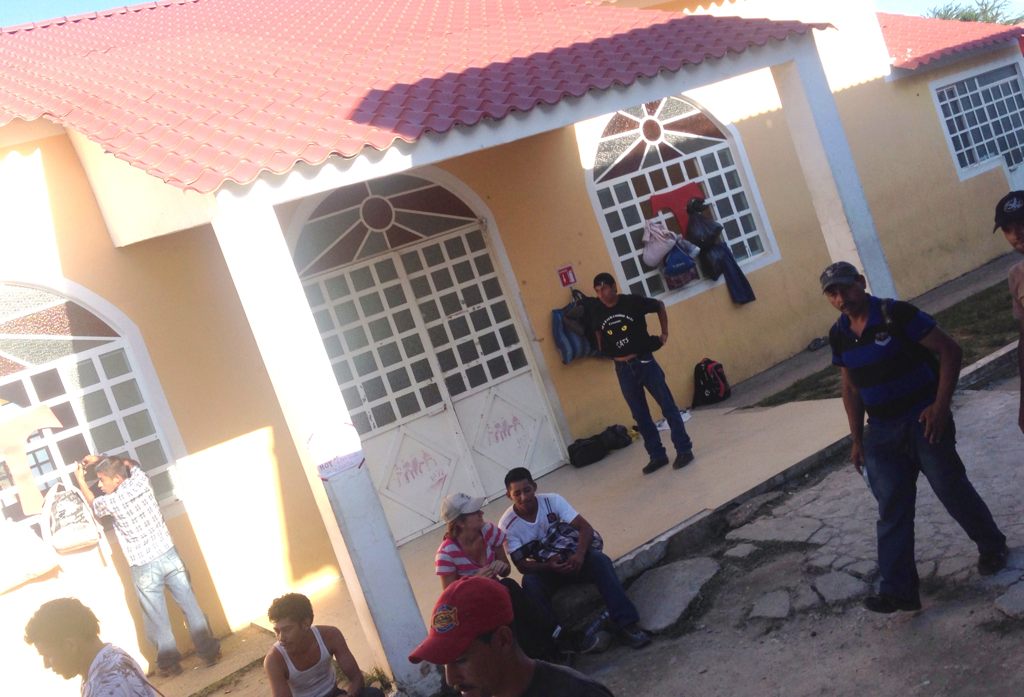
The “La 72" migrant shelter in Tenosique.
Between 2012 and 2013, these shelters saw demand for their services nearly double as the exodus from Honduras intensified. Within this migrant population, the proportion of women increased from single-digit percentages to nearly 20 percent, and there has been a higher incidence of both entire families and unaccompanied minors.
Migrants say they are being pushed out by a lack of economic opportunities. “We’re living on one meal a day, there’s no work,” a mother from Comayagua, Honduras told us in the Tenosique shelter. Several specifically used the phrase “sueño americano” (American dream) to voice their hope of escaping poverty in the United States. The World Bank estimates that 34.5 percent of the Salvadoran population is living below the country’s national poverty line, while this rises to 53.7 percent in Guatemala and 60 percent in Honduras.
It is not just poverty, however. Residents of El Salvador, Guatemala, and Honduras are also being pushed northward by the world’s highest levels of criminal violence. According to the UN Office on Drugs and Crime (UNODC), Honduras currently has the highest homicide rate in the world with 90.4 homicides per 100,000 residents. As a region, Central America joins Southern Africa as the sub-regions with the highest homicide rates, four times higher than the global average. Much of the violence is the work of international, loosely tied networks of youth gangs, called maras, that began within the Central American migrant community in the United States in the 1980s. Today, the Mara Salvatrucha, Barrio 18, and smaller organizations control towns and neighborhoods throughout Central America, using extreme brutality to control income streams from extortion, kidnapping, prostitution, and street-level drug trafficking.
Young people flee to evade gang recruitment or harassment, and some teenagers we interviewed spoke vaguely of fleeing from gang trouble. Business owners, even those in the informal sector, flee extortion. Corrupt security forces’ inability to protect citizens too often leaves them with no choice but to leave.
A UN High Commissioner for Refugees (UNHCR) representative in Tapachula told us of increasing numbers of entire families of Hondurans, including many with young children, leaving their home country due to persecution from gangs or maras. They express fears that adolescent boys will be forcibly recruited by the maras, and that adolescent girls will be used for prostitution.
In fiscal year (FY) 2013, U.S. Customs and Border Protection (CBP) apprehended 21,537 unaccompanied children from El Salvador, Guatemala, and Honduras, a dramatic increase from 4,059 apprehensions in FY 2011. In the first eight months of FY 2014, the number surged still further, to a stunning 34,611, overwhelming U.S. Homeland Security and Health and Human Services agencies’ capacity to accommodate them. An internal draft Homeland Security memo from June 2014 estimated that the number of unaccompanied children, mostly Central Americans and Mexicans, could climb to 90,000 for the fiscal year. (CBP has also recorded a more modest, but significant, increase in apprehensions of unaccompanied Mexican children, going from 11,768 in FY 2011 to 17,240 in FY 2013 and 11,577 in the first eight months of FY 2014.)
In a recent report on unaccompanied children leaving Central America and Mexico, UNHCR found approximately 56 percent of interviewed children from El Salvador, Guatemala, and Honduras with potential international protection needs. The UNHCR study found that not all unaccompanied children were seeking their parents or other family reunification, or looking for better economic opportunities. Some were fleeing violence: either violence related to organized criminal groups or domestic, intrafamily violence. The report stated that the number of asylum requests by children had increased by 432 percent. A November 2013 mission by the United States Conference of Catholic Bishops (USCCB) to Central America and Chiapas concluded that while several interrelated factors have contributed to the spike in migration of unaccompanied children, a decisive and important role has been played by “generalized violence at the state and local levels and a corresponding breakdown of the rule of law [which] have threatened citizen security and created a culture of fear and hopelessness.”
In 2012, the INM reported a 46.6 percent increase in detentions of unaccompanied migrant children, reaching 6,100 for that year. In 2013, the INM returned 8,350 migrant children to their home countries. Nearly all—8,222—were from Central America, 44 percent from Honduras.
The situation of child migrants has become even more urgent due the conditions in which they travel, the way they are detained, and the procedures that are applied. In mid-May 2014 the Department of Homeland Security declared an emergency—or “four level condition of readiness”—due to high numbers of unaccompanied migrant children arriving in south Texas, which had overwhelmed the capacities of Border Patrol, other enforcement agencies, and child welfare services. On June 2, President Obama called the situation an “urgent humanitarian crisis” and requested from Congress an additional $1.4 billion in funds to assist federal agencies (it was later stated that this number could double). He appointed Craig Fugate, the head of the Federal Emergency Management Agency (FEMA), to oversee the situation.
While Mexican migrants, including unaccompanied children, are promptly returned to Mexico, Central American migrant children must be held, processed, and transferred within 72 hours to the Department of Health and Human Services. The children then remain in agency-contracted shelters until a family member, sponsor, or foster parents can be found to keep custody over them while they go through immigration court hearings. Due to the extreme violence from which many of these children are fleeing, as well as cases in which children have been victims of intrafamilial violence or human trafficking, a number of them would likely qualify to receive asylum or another permission to stay in the United States. However, these children often do not have access to lawyers, and groups that work to find pro bono legal assistance cannot meet the demand.
U.S. agencies face urgent challenges to address the wave of unaccompanied children at the border. Mexico—which has seen a less steep, but notable, increase in the number of migrant children apprehended in 2014—also faces challenges to protect this population which, like other migrants, faces multiple dangers on the journey through the country. As in the United States, migrant children arriving in Mexico—even those who would qualify for asylum—often fail to receive the protection they need.
One issue is law enforcement and protection officers’ lack of training in the identification and screening of vulnerable children. Migrant children may be placed in detention with adults, as Mexico has only two shelters specifically for children, one in southern Mexico and another in Mexico City, administered by the Integral Family Development agency (Desarrollo Integral de la Familia, DIF). If a child decides to request asylum, he or she may remain in detention for several months, leading some to desist from their requests in order to get out of the detention center and return to their home countries. In many cases, they will try the journey again.
A rising number of both children and adult migrants are seeking protection and asylum in Mexico. The quest for asylum often starts in southern Mexico, the first point of entry in the country.
UNHCR, which has had a presence in Chiapas since 1982, has long worked on the asylum issue. While in the 1980s it attended to Guatemalan refugees fleeing civil war, in recent years it has supported refugee status requests for individuals from Colombia, African countries, and more recently the large wave of Central American migrants fleeing violence and extortion.

Honduran migrants write their names in chalk and charcoal on a highway overpass in Lechería, north of Mexico City.
Statistics about refugees in Mexico note 1,164 requests for refugee status in 2013. Applicants’ top four countries of origin were Honduras (455), El Salvador (285), Cuba (92), and India (88). Of these requests, only 245 were granted refugee status and 35 received complementary protection. Within this group, the top four countries of origin were Honduras (99), El Salvador (84), Nigeria (14), and Syria (11).
This approval rate is very low given the demand for asylum rights in the southern border region. According to information obtained by the Tapachula-based Fray Matías de Córdova Human Rights Center, an informal policy seeks to discourage people from pursuing asylum claims by subjecting them to prolonged internment in INM detention centers. The conditions in these sites, along with the infringements on their rights that occur there, cause many people facing real persecution to abandon their right to petition for asylum. Instead, they decide to join the flow of migrants who cross Mexico without receiving the international protection to which they are entitled.
Central American asylum applicants’ requests indicate threats of what seem to be systematic violations of their human rights, such as torture, forced disappearances, and extrajudicial executions. The most dramatic case is that of Honduras where, for example, the Inter-American Human Rights Commission, in a May 2014 communiqué, offered revealing information:
The Inter-American Commission emphasizes that these acts have taken place in a context of widespread violence and citizen insecurity that places children and adolescents in a particularly vulnerable position.… According to the National Commissioner on Human Rights (National Ombudsperson) of Honduras, from 2010 to 2013 at least 458 children under 14 years of age died in violent circumstances in Honduras; and according to information from the organization Casa Alianza, in the first three months of this year [2014] 271 children and youths under 23 years of age have been assassinated.
During the first three months of 2014 Mexico carried out 18,696 of the deportations that the Migration Law calls “assisted returns.” Of these, 2,851 were of individuals below 18 years of age. Under the category of “return by deportation,” Mexico repatriated another 359 people. (Note that these statistics register deportation events, not people. Two events, for instance, can be associated with the same person.)
Migrants traveling through Mexico to reach the U.S.-Mexico border are subject to multiple abuses and human rights violations by criminal groups and Mexican officials. During the past few years, many Central American migrants with whom we have spoken about their journey north report that traveling through Central America was not a problem: the violence and abuse started in Mexico. While migrants have historically been victims of abuse during their travels, the number and severity of these abuses has increased substantially of late, as organized criminal groups operating along the migrant transit route have diversified their activities beyond drug trafficking to include human trafficking, kidnapping, and extortion.
Apart from the risks of riding the train (discussed below), migrants frequently fall victim to crime and abuse when they use other transport or when they are in public areas like bus stations. Migrants have even been abducted and abused in the vicinity of migrant shelters.
A November 2013 report by the Documentation Network of Migrant Defense Organizations (Red de Documentación de las Organizaciones Defensoras de Migrantes), in collaboration with the Jesuit Migration Service, analyzed 931 testimonies of migrants gathered by seven shelters in Mexico during the first six months of 2013. Of those surveyed, a staggering 52 percent reported being robbed and 33 percent reported being extorted, primarily by criminal groups. More criminal acts were committed in Chiapas (38 percent) than in any other Mexican state. Approximately 18 percent of the abuses were committed by Mexican authorities, with the Federal Police at the top of the list (35 percent), followed by municipal police forces (31 percent). These abuses included extortion, robbery, and abuse of authority, among others.
Based on conversations with shelter staff as well as testimonies from migrants, it is clear that police at all levels target migrants riding on buses or combis (passenger vans), interrogate them about their migration status even though they have no authorization to do so, and extort them with the threat that if they do not pay, they will be turned over to the INM.
In March 2014, Fray Tomás González, director of the “La 72” migrant shelter in Tenosique, Tabasco, denounced abuses by INM agents against a group of migrants. He reported that the agents took the migrants into the jungle, removed two of them from the vehicle and threatened them, stole their money, threatened them again, and then abandoned them. Prior to this incident, González had denounced that Federal Police agents charged with protecting the La 72 shelter had detained, beaten, and threatened two migrants who were staying there.
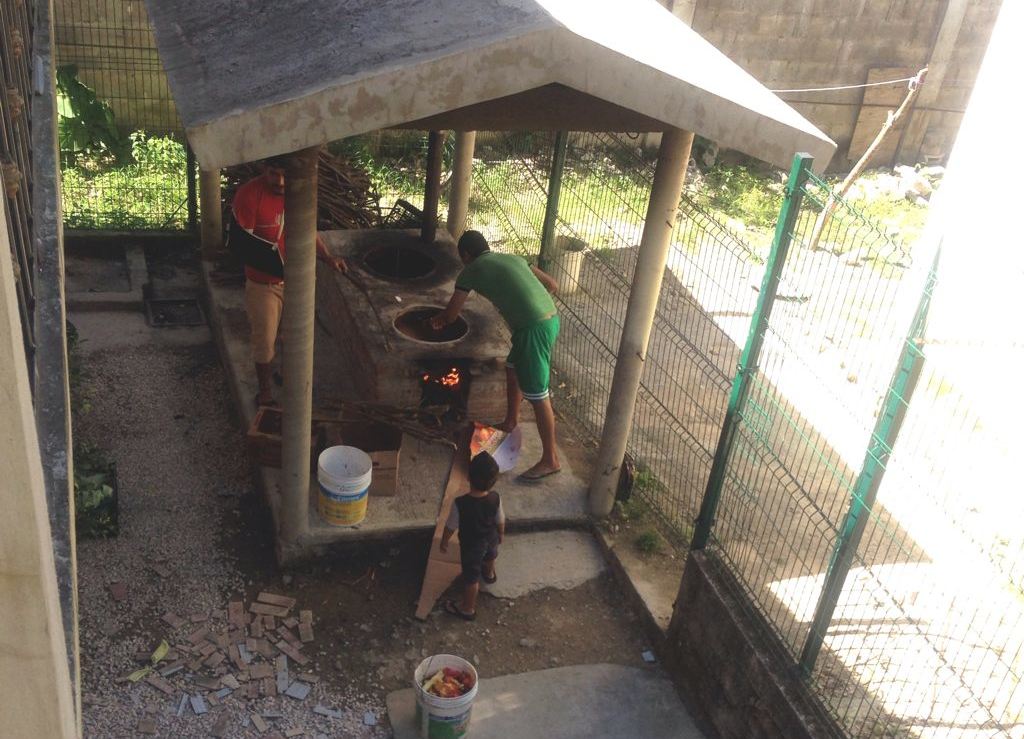
“El Caminante” migrant shelter, Palenque.
Corruption is acute at road checkpoints, according to numerous testimonies from community leaders, migrants’ defenders, human rights defenders, and migrants. Bribes routinely allow drug, human, or other traffickers to pass through unhindered.
The Chiapas-based human rights defenders we interviewed in San Cristóbal de las Casas saw little near-term hope that this culture of corruption might change. Where drug interdiction and migration control are concerned, they said, Mexican forces will do the bare minimum that the U.S. government asks of them, in order to keep receiving assistance in the form of new facilities, vehicles, technology, training, and intelligence.
Though the borderline itself is porous, Mexico has chosen to enforce its borders further inland. As the distance from Central America increases, so do migrants’ chances of running afoul of Mexican authorities. Roadblocks and checkpoints, discussed below, make it difficult to travel to the U.S. border along Mexico’s road network.
Difficult, that is, but not impossible. Migrants who can pay smugglers’ fees encounter far fewer obstacles from officials on the region’s roads, according to testimonies from migrants’ rights and human rights defenders. As smugglers pay fees to criminal groups (and at times Mexican authorities) who control the migrant routes, they are more likely to enjoy safe passage, with a significantly lower probability of abuse and violence.
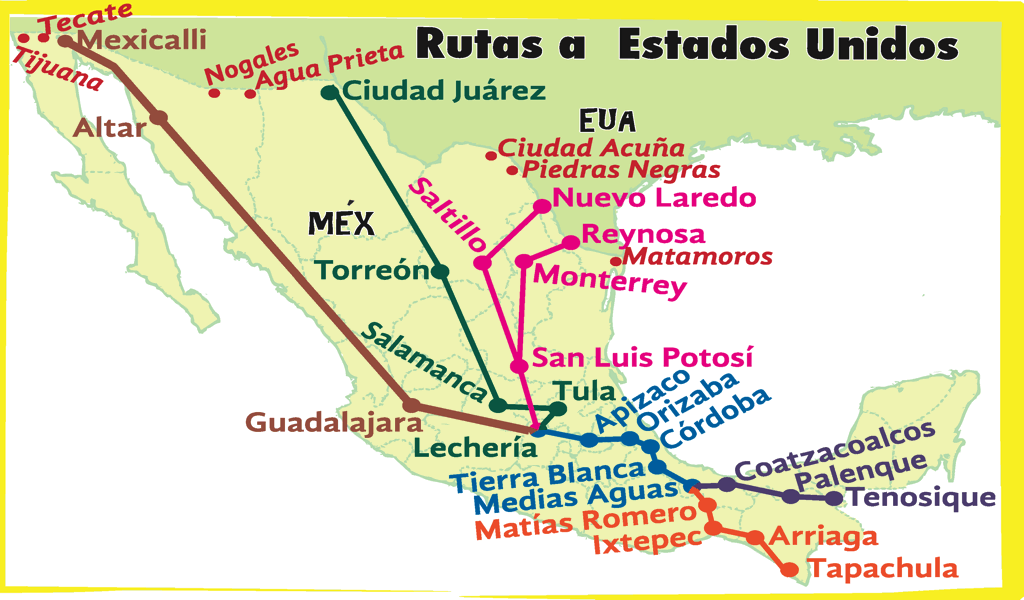
This map from the Jesuit Migrant Service illustrates the main cargo train lines and stops. The pink line is the far shortest route to the U.S. border, which explains why south Texas has seen the vast majority of Central American migrant arrivals.
Generally, the most vulnerable migrants are those who cannot afford to hire a smuggler, whose fees for transit across Mexico can exceed US$8,000. For the tens of thousands per year who lack such resources, Mexico’s cargo train network is far less policed than the road network. This is so for reasons that we did not hear explained clearly. Migration officials’ comments appeared to ascribe responsibility to the cargo train companies themselves, although the tracks run on federal land.
Whatever the reason, the chance of encountering authorities is far lower on the tracks. Migrants in the southern border zone are drawn to “La Bestia” (The Beast), the train that heads northward to central Mexico and then on to the U.S. border. For hundreds of miles they ride on the roofs of the train cars trying to avoid fatal falls, hot days, frigid nights, and low-clearance tunnels. Every eight to ten days or so, trains depart from two routes that originate near the southern border.
Migrants currently board the train’s northern route in Tenosique, Tabasco or Palenque, Chiapas, following a track along the Gulf of Mexico through Veracruz. Another route, following Chiapas’ Pacific coast, used to begin in Tapachula, until the track was destroyed by Hurricane Stan in 2005. Now, the route starts in Arriaga, Chiapas, from where it passes through Oaxaca and north to Veracruz.
This means that migrants arriving in Tapachula must walk—or risk road transport—to Arriaga, 150 miles to the northwest. This journey, which might take a migrant two weeks on foot, is treacherous. In order to avoid the eleven checkpoints that we counted between Tapachula and Arriaga, migrants will often dismount combis or taxis before the checkpoint, walk miles in brushland, and then board another combi on the other side of each checkpoint. For years, migrants on this journey have been robbed, beaten, sexually assaulted, and even killed, particularly in an area commonly known as “La Arrocera” in Huixtla municipality.
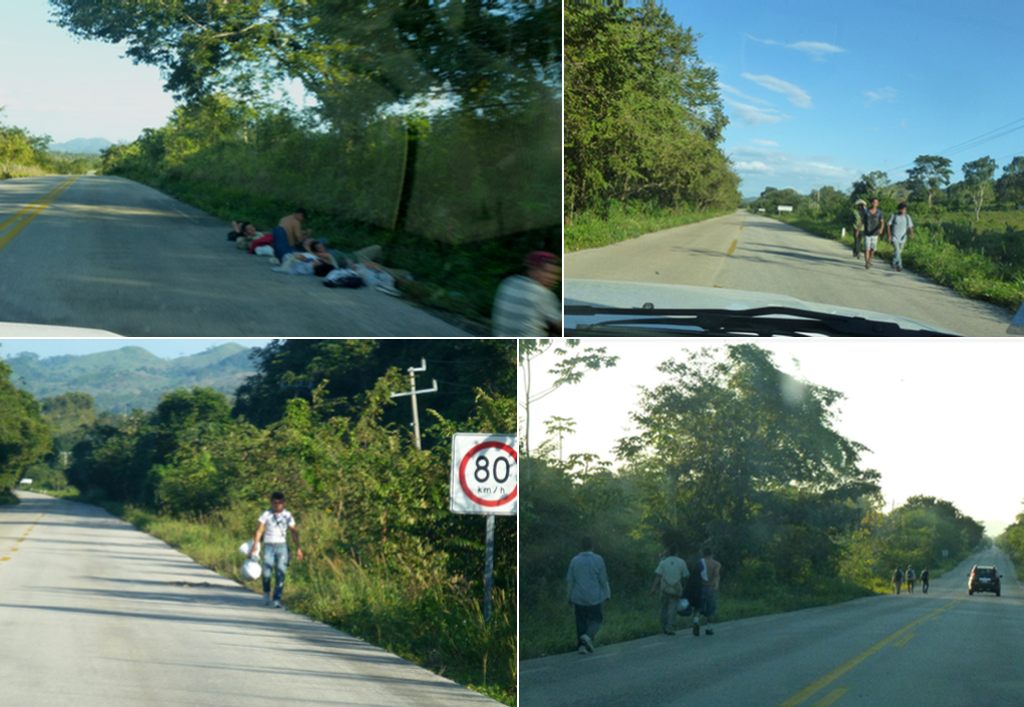
Numerous migrants making the 35-mile walk from the Guatemalan border to Tenosique, the train stop closest to the Petén.
In Tabasco, where 35 miles stand between the Guatemalan border and the northbound train line in Tenosique, migrants either pay to hitch a ride, or travel on foot. Along this route—a swampy stretch that often requires migrants to walk along the main road—the stream of migrants is constant. We saw at least one hundred migrants during a two-hour, there-and-back drive. They were individuals of all ages; the majority were probably males in their late teens or early twenties, although we also saw younger teenagers, men in their 40s and 50s, small groups, and women. In the Tenosique and Palenque migrant shelters, we saw some families, often with babies, who had taken this road. Nearly all were Honduran.
Mexican immigration authorities do carry out periodic sweeps along the road, capturing migrants whom they detain or deport back into Guatemala. These sweeps are infrequent enough, though, that migrants are not dissuaded from walking on the roads between the border and the beginning of the train line. The danger of being robbed or assaulted along this 35-mile stretch of road, especially at night, is likely greater. Some enterprising Mexican smugglers charge migrants a steep fee to drive them, usually in the backs of pickup trucks, over this distance.
After years of repair, the train along Chiapas’ Pacific coast will once again start in Tapachula sometime in 2014. This may reduce the dangers for migrants in this part of Chiapas, as they no longer will have to make their way to Arriaga to reach the train. Nevertheless, getting to the train is only one part of the dangerous journey.
The same Central American gangs that have made life unlivable in places like Honduras are present all along the train lines in southern Mexico. Operating with very little challenge from Mexican authorities, the Barrio 18 and Mara Salvatrucha gangs extort their countrymen as they migrate away from their countries of origin. The Central American criminal gangs—at times working with Mexican counterparts—have ensured, largely through state corruption, that they have freedom to prey upon the migrants traveling on the trains.
Migrants and shelter personnel told us—and have denounced publicly—that in Arriaga, Palenque, Tenosique, and at least part of Veracruz, the Central American gangs are currently charging a fee of US$100 for permission to ride atop the train. Different groups dominate different segments of the journey north, and each charges fees, meaning that a migrant is often forced to pay hundreds of dollars for a “safe” passage on the trains across Mexico. Those who cannot pay are either abused or pushed off the train while it is moving, or prohibited from climbing aboard if the money is collected beforehand. Honduran migrants we spoke to in Nogales, Sonora in April 2014 reported that they had seen two migrants thrown off the train because they did not have any more money to pay the fee.
Also in April, an official from the Oaxaca State Attorney General’s Office confirmed that two massive assaults had recently occurred against migrants riding on the train that departs from Arriaga. In another incident, on April 4, 2014, four migrants on that train were killed and three were injured by a criminal gang’s assault.
Individuals we interviewed expressed concern about possible collusion between criminal groups and the train company or train operator. They cited incidents in which a train stops in a remote area for no apparent reason, and criminal groups then board it to rob and abuse migrants. In other cases, coyotes (human smugglers) traveling with the migrants will pay the train operator to stop to let migrants climb on board. Many of these smugglers are also armed, as they claim they must protect their “merchandise.”
Once the train resumes operating out of Tapachula, criminal gangs currently based in Arriaga will most likely shift their operations south, adding to an already complex set of dynamics facing migrants in this border area. This year has seen a rise in Central American gang activity in the Soconusco region; jockeying to dominate stops along the soon-to-be-restored train line is a likely reason.
Further north along the train line is Veracruz, which migrant defenders and shelter personnel regard to be the most dangerous segment of the journey between the southern border and Mexico City, even though surveys of migrants indicate that more abuse occurs in Chiapas. There, heavily armed kidnappers, many reportedly tied to the Zetas, act so brazenly that, according to numerous reports, they are able to stop trains and force migrants to board their late-model pickup trucks.
Migrants kidnapped by criminal groups are taken and held in safe houses, under unspeakably brutal conditions, until relatives, usually in the United States, pay steep ransoms. Many of their captives are never seen again. Migrants on the train line, who are assumed to be carrying cash, also face the threat of regular banditry by groups of bajadores who assault and rob them.
Migrants and shelter personnel told us that the gang extortion, kidnapping, and banditry problems have worsened dramatically in the past few years as Central American migration has increased. The response from the security forces has been scarce. Throughout the train line—usually in exchange for payment—corrupt federal, state, and municipal police, as well as railroad employees, turn a blind eye to the criminal groups’ marauding, and at times aid and abet it.
This dynamic may be changing. In late March 2014 the governor of Veracruz, Javier Duarte de Ochoa, lodged a criminal complaint before the Attorney General’s Office (PGR) against two train companies operating in southern Mexico, Ferrosur and Kansas City Group (KCSM). Governor Duarte argued that because they allow migrants to ride on top of the train, the companies are complicit in the crimes against migrants that occur on the train. He accused some train workers of being accomplices of organized crime, and alleged that some workers also commit crimes directly against migrants.
As a result of the governor’s complaint, the train companies began to prohibit migrants from traveling on the Tenosique-Palenque train line, which resulted in a concentration of migrants in southern Mexico. Some large groups decided to walk towards central Mexico in the hope of picking up the U.S.-bound train hundreds of miles to the north. In at least one massive detention operation, discussed below, the migrants’ decision to travel on foot through Mexico put them at greater risk of abuse by Mexican authorities. As of early June 2014, it is unclear whether the train companies are continuing to prohibit migrants from riding on the train.
Troublingly, our conversations with migrants, and shelter workers’ own assessments, revealed that many of the travelers have only a vague idea of the dangers that await them, whether on the train or in the forbidding deserts on the U.S. side. Shelters attempt to educate about the risks further north, and more information comes from smugglers or from the minority of migrants, mostly deportees, who have made the trip before. Still, too often our questions about the journey’s dangers were met with a shrug, an expression of faith in God, and the observation that their place of origin is dangerous too. They also noted that life in Honduras, Guatemala, and El Salvador had already taught them to distrust uniformed security forces.
The train lines that begin near the Guatemalan border end up at a series of junctions north of Mexico City, in working-class suburbs in the state of Mexico. Migrants dismount in the neighborhood of Lechería in Tultitlán municipality, but are not permitted to await and board new trains there. They must walk about 15 miles north to Huehuetoca municipality, and from there they can board trains to Tijuana, Ciudad Juárez, Nuevo Laredo, or Reynosa. Most Central American migrants choose the latter two, as south Texas is a far shorter journey.
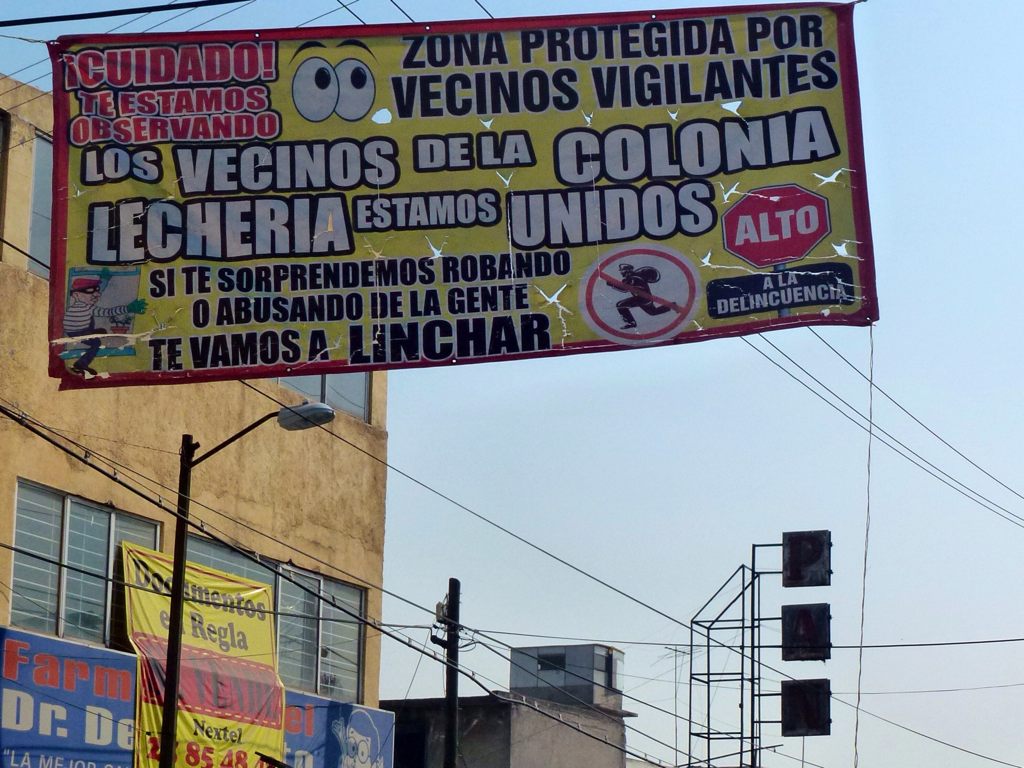
In Lechería, where many residents associate migrants with petty crime, a banner warns, “If we catch you robbing or abusing people, we are going to lynch you.”
In Lechería and Huehuetoca, anti-migrant sentiment borders on xenophobia. The local population views migrants as a nuisance, associating them with behavior like petty theft, vandalism, and panhandling, and makes clear that those who arrive on the trains should keep moving on. Shelters have had a hard time staying open here in the face of determined opposition, and even threats and acts of aggression. In Lechería, where a shelter was forced to close, cash-strapped volunteers are reduced to operating a kitchen that brings meals to migrants camped out in open places, like under highway bridges. In these encampments, migrants face a high risk of falling prey to kidnappers and thieves, who again act with little opposition from the authorities.
With modest but increasing U.S. support, the Mexican government is responding to the rising tide of Central American migration (and the continued flow of drugs and other illicit goods) by intensifying its border security measures. Conceptually, this means a turn toward more policies that view migrant flows as a threat to be controlled, instead of a humanitarian phenomenon to be managed or a vulnerable population to be protected. While Mexico has considered migration to be a national security issue, as was made clear by the INM's 2005 incorporation into the National Security Council, efforts to increase a security presence along the country’s southern border are rather recent.
Between December 2013 and April 2014, we carried out a series of interviews with nine organizations working in several points along Mexico’s southern border. Due to their work on human rights and migrants’ rights, these groups have regular contact, both direct and indirect, with migrants in the border zone. All view border security as an important part of their work. They propose a “human security” framework for the region, in which security should be centered on the people rather than on the state, as a way to minimize the risks that migrants face on their journey. Being able to exercise their rights amounts to a type of protection and a way to improve relations with local residents, among whom anti-migrant sentiment often runs high.
Amid the steadily accelerating buildup, a constant question we heard was, “What security, and security for whom?” All attested that the physical security of the migrant population with whom they work is deteriorating.
The local organizations’ perplexity owes in part to a lack of good information about what Mexico’s current border security strategy actually is. They are observing some recent changes, and greater expressions of interest in the southern border, but official information about these measures remains opaque, dispersed, and apparently unlinked to a larger policy.
One of the most notable changes they have observed is a greater presence of the security forces, including the Army, Marines, and Federal Police, working in the border region. This proliferation of units with overlapping responsibilities has been accompanied by reports of human rights violations, such as abuse of authority, mistreatment, and the abuse and extortion of migrants. The population’s confusion about the identities of so many military and police units generates an atmosphere of impunity for those responsible for abuses.
In northern Chiapas, a heavy presence of police and soldiers has been a constant since the 1990s Zapatista uprising. Near the border and in the Soconusco region, however, this is a new phenomenon, leading the population to believe that overall crime and insecurity are worsening.
Some Mexican authorities have denied that the increased security force presence is part of a strategy to fortify the southern border—at least, that was the response of INM officials whom we interviewed in Mexico City. By contrast, officials charged with southeast border security in the Secretariat of the Interior’s National Security Commission spoke of an effort to build a southern border security program with two lines of action: “security for development” and “development for security.”
The Mexican government apparently has been developing this “macro” strategy since October 2013. While the resulting increase in federal security personnel had been gradual, beginning in January 2014 we noted a more rapid deployment of Federal Police and of Federal Ministerial Police, an investigative unit attached to the Attorney General’s Office (PGR).
Other new elements include: the construction of Advanced Naval Stations, remote Marine posts first built after the Zapatista uprising; the introduction of canine teams in the Tapachula airport; and joint patrols in the city of Tapachula. In April we observed such a patrol integrating the INM, the Federal Police, the Federal Ministerial Police, the Chiapas State Border Police, and the Army. The inclusion of combat-trained military personnel on routine patrols risks the explosive reaction that Mexico’s northern border witnessed after 2006, when the armed forces became massively involved in public security.
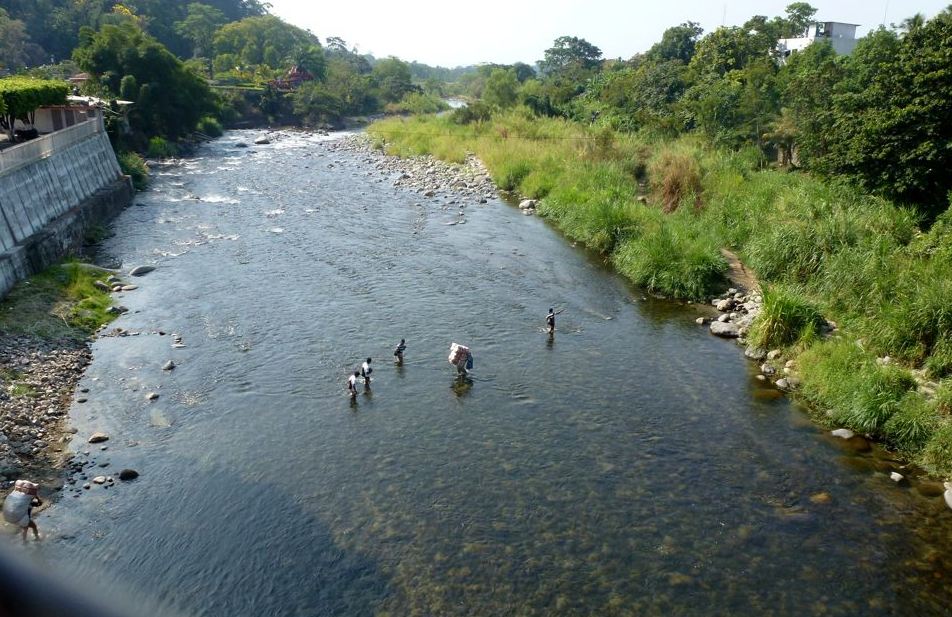
Individuals carrying cargo, likely for sale on the Mexican side of the border, wade the shallow Suchiate River from Guatemala. This photo was taken from the official port of entry bridge at Talismán, Mexico.
Detecting or deciphering a single government strategy to guide this buildup has been difficult. The general lines of what we have observed, however, would indicate the following:
Amid fragmentary official information and numerous public statements in recent months, we have pieced together the following Mexican government policy announcements.
On June 3, 2013, Tapachula hosted a southern border security meeting attended by the secretaries of Interior, Defense, and Navy; the Attorney General; the chiefs of the Federal Police and civilian intelligence (Centro de Investigación y Seguridad Nacional, CISEN); and the governors of Campeche, Chiapas, Quintana Roo, Tabasco, and Veracruz. These officials agreed on the need to register formally all individuals who cross the southern border, to attend to migrants crossing through the zone, and to improve coordination with Guatemala and Belize. They also placed Mexico’s Navy (Marines) in a coordinating role for southern border security.
The result is an effort by federal and state entities to coordinate and direct government investment in infrastructure and other economic development projects in Mexican states near the southern border. This “Integrated Development Plan” is a component of the Mexican government’s larger National Development Plan, with which the Peña Nieto government guides programming and budgeting.
In April 2014 Mexico’s government published a diagnostic study of economic conditions and migration patterns in the southern border zone. The document indicates some priority municipalities and economic sectors. As of mid-2014, though, the Integrated Development Plan has not guided any new investment.
This program devotes resources to infrastructure and public works projects in border states. Within the framework of this program, on November 28, 2013, President Peña Nieto announced the closure of several official border crossings with Guatemala as a cost-saving measure. In Chiapas, the Viva México, Tzimol, and Quija crossings have been shut down.
The Customs agency (SAT) is a component of Mexico’s national security policy, and it has seen its presence near the southern border bolstered as part of a 2007-2012 modernization program. The most visible element is the construction of three new internal control facilities at key Chiapas highway crossroads in Huixtla, La Trinitaria, and Palenque, discussed below.
This U.S.-backed INM strategy seeks to control migration flows through documentation, which in turn relies on greater physical and technological infrastructure. U.S. officials managing support for this program insist that the idea is not to encourage Mexico to seal its southern border, as the United States has done with its own border. Instead, the objective is for Mexico to have a better idea of who is crossing.
A key example has been a pilot biometric registry program at the southern border, announced by the INM in November 2013. US$14 million in Mérida Initiative funds are supporting the creation of a database of legal border crossers, which is being integrated with Plataforma México, the national network of public security databases. This program is being implemented at 47 points in the states of Chiapas, Quintana Roo, Veracruz, Tabasco, and Yucatán, especially at border state migrant detention centers and facilities that issue migrant work visas.

The recently built entry facility at Ciudad Hidalgo, Mexico. New biometric kiosks are inside.
The first delivery of such equipment at the southern border occurred in 2011, when U.S. Ambassador Earl Anthony Wayne presided over the handover of four biometric kiosks to the INM. These were installed at four border crossings with Guatemala.
The effort to strengthen record-keeping about border crossers continues. In January 2014 the INM and Mexico’s national security cabinet announced the creation of a Center for Migration Intelligence (Centro de Inteligencia Migratoria), which will seek to control flows of people through official migration filters, including border posts.
This program was announced at an April 22 forum in Mexico’s Senate. As of mid-2014, however, no information about it appears on the INM website or elsewhere. When she announced it, Undersecretary of Interior for Population, Migration, and Religious Issues Mercedes del Carmen Guillén said the program will provide border work cards and regional visitor cards at no cost to citizens of Guatemala and Belize. Except for making these documents free of charge, it is not clear how this differs from current programs. Guillén also stated that the program will work to strengthen migrant shelters at the border.
Some of Mexico’s various southern border security strategies have received U.S. support under “Pillar 3” (“Create a 21st-Century Border”) of the Mérida Initiative aid package. As of February 2014, the State Department reported that the Mérida Initiative has allocated $112 million in technology for border security, “including non-intrusive inspection equipment, improvement of infrastructure, and personnel training in the areas of border security.” An unknown, likely smaller, additional amount—much of it for Mexican Navy / Marine facilities and training—has come from the Defense Department’s counter-drug budget.
Most “Pillar 3” aid has gone to the northern border zone, but that may change as concern grows about increased flows of Central American migrants and the steady flow of drugs up from Central America. U.S. aid deliveries slowed after the Peña Nieto administration took power in December 2012 and sought to re-evaluate cooperation programs. Starting in August 2013, however, U.S. and Mexican officials have held a series of working group meetings to set priorities for future assistance. Bolstering security along Mexico’s southern border is one of those priorities.
To date, U.S. assistance at the southern border includes the following.
In the immediate border zone, where migration is a generations-old custom, people routinely wade or take inner-tube rafts across the river, often within plain sight of official border crossings. For the equivalent of US$1.50 per person, a raft took us from Tecún Umán, Guatemala to Ciudad Hidalgo, Mexico. The whole process, from negotiation to hopping off the raft into Mexico, took about five minutes.
 Rafts cross the Suchiate River between Tecún Umán, Guatemala and Ciudad Hidalgo, Mexico.
Rafts cross the Suchiate River between Tecún Umán, Guatemala and Ciudad Hidalgo, Mexico.
The ease of informal crossing makes facilities recently constructed at border crossings appear incongruous. Personnel from INM and Customs staff ten official ports of entry between Guatemala and Mexico. The four that we saw up close (El Ceibo, Ciudad Cuauhtémoc, Talismán, and Ciudad Hidalgo) all showed evidence of recent or ongoing construction: gates, walkways enclosed by bars, and in some cases, the brand-new, U.S.-provided biometric equipment discussed above.
The biometric kiosks, now installed at four southern border crossings, collect information about border-crossers in a database that, a U.S. Embassy document avers, “will be a powerful tool to support judicial proceedings and counter terrorism efforts.” The equipment, part of a larger US$58 million Mérida Initiative biometric program mainly benefiting the National Migration Institute, registers crossers’ fingerprints, irises, and facial characteristics. This information is linked to Mexico’s public security database network as part of the “Migration Program for the Southern Border of Mexico” discussed above.
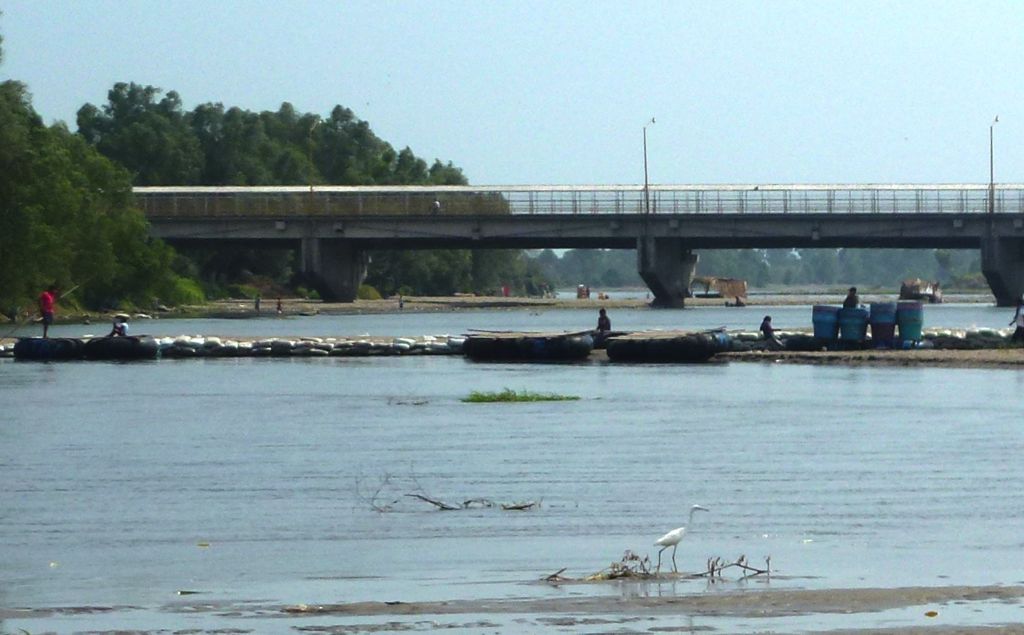 The bridge in the background, just downstream from the rafts, is the official port of entry between Tecún Umán and Ciudad Hidalgo.
The bridge in the background, just downstream from the rafts, is the official port of entry between Tecún Umán and Ciudad Hidalgo.
The Mexican and Guatemalan governments’ envisioned outcome, as U.S. Department of Homeland Security officials explain it, would involve both governments maintaining databases of all border-crossers. Individuals would still be allowed to circulate in the border zone, using cards that store biometric data. These border-crossing cards exist; Mexico issues them at no charge to Guatemalan applicants. They allow Guatemalan citizens to remain up to 100 kilometers inside Mexico for up to three nights.
Despite the recent equipment deliveries, this plan is far from implementation. From the official ports of entry—steps from the biometric data kiosks in Ciudad Hidalgo—one has an easy view of people wading or floating across the Suchiate River, often carrying bales of uninspected parcels. The juxtaposition between the official bridge crossing and the free-flowing rafts and waders is remarkable, especially for an observer familiar with the tightly guarded U.S.-Mexico border.
In zones where the border is land, not river—a straight line marked by monuments—getting across is even easier. All ten crossings have official customs and migration stations on both sides. A short distance from these crossings, however, the line is a faint geographical feature: both countries clear trees and brush from the borderline for about five yards on each side of the line.
 The “model border crossing installation” at El Ceibo.
The “model border crossing installation” at El Ceibo.
In El Ceibo, a road crossing where the border between Tabasco, Mexico and Petén, Guatemala forms a 90-degree corner, Mexico’s border facility resembles those on the U.S. side of the U.S.-Mexico border. Guards stand at the ready, and pedestrians are confined to a walkway by at least 100 yards of metal bars. El Ceibo is considered a “model border crossing installation… the first of eight new model border crossing points designed to new specifications,” according to a 2009 State Department cable.
Mere yards to either side of this “model crossing,” however, the border is open. From a soccer field on the Guatemalan side, missed shots on goal can easily bounce into Mexico. Yards further still, crossing the border without attracting authorities’ notice poses no challenge.
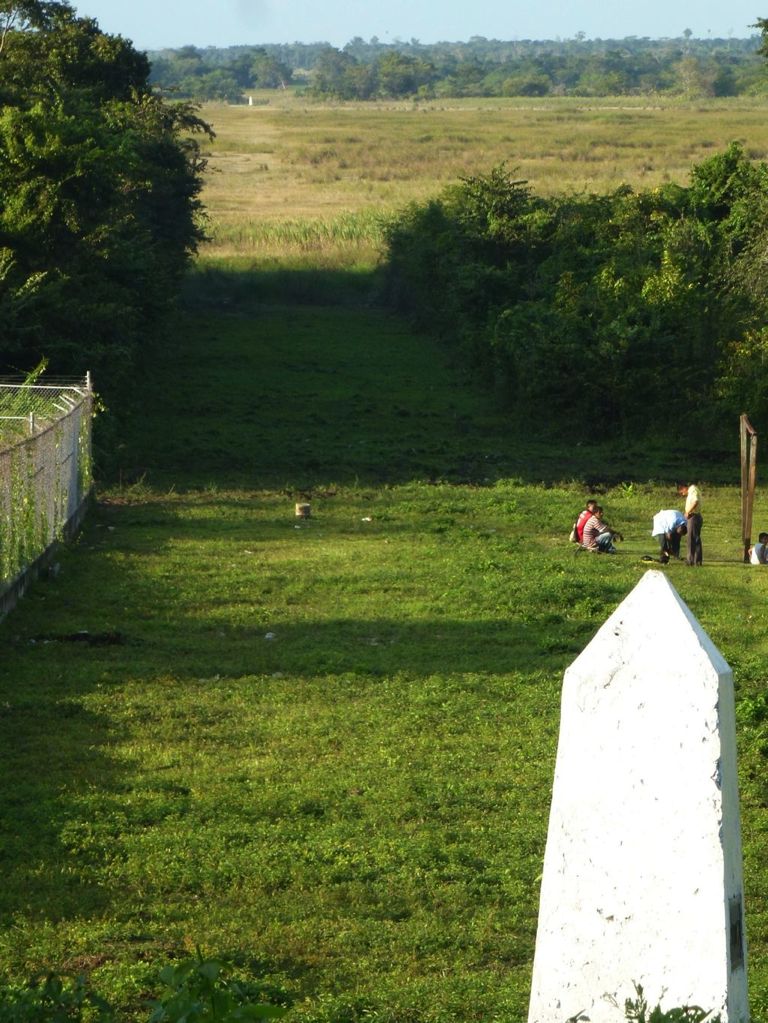
Soccer field right next to the El Ceibo border crossing. The border, right behind the goalpost, is the cleared area in the background.
Migrants disembark buses on the Guatemalan side, leave the road on foot before the border crossing, and rejoin the road inside Mexico. This is how virtually all of those whom we observed on the road between the border and Tenosique arrived in Mexico.
While cross-border flows are very free within a dozen or more miles of the borderline, Mexico’s migration and customs enforcement tightens further into the interior. The INM “migration stations” (detention centers) are routinely at capacity; these detainees are chiefly captured far from the borderline, lending credence to the idea that there is indeed a “vertical border” within Mexico.
 Approaching an Army checkpoint in a remote zone near the border with Quiché, Guatemala.
Approaching an Army checkpoint in a remote zone near the border with Quiché, Guatemala.
According to March 2014 statements from the Mexican government’s National Security Council, the Peña Nieto administration plans to organize its border security efforts in three virtual geographic tiers, or “belts of control,” at fixed distances from the border. The first line runs roughly 30 miles from the Guatemalan border, “in the zone of Huixtla, Suchiate, Arriaga, Trinitaria, Comitán, Benemérito de las Américas, and Palenque.” The second is about 100 miles from the border, and the third is the Isthmus of Tehuántepec, Mexico’s narrowest point, which forms a sort of bottleneck. (See the belts’ approximate location on the map above.)
At each “belt of control,” along main roads, crossings between principal roads, and in coastal zones, Mexican authorities would maintain checkpoints where officials from security, migration, investigative, and customs agencies would interview and search travelers, at times using sophisticated U.S.-donated scanning and sensing equipment.
The Peña Nieto administration discussed this three-tier plan with the Obama administration in mid-2013, according to unnamed U.S. officials cited in an investigation by the conservative Washington Free Beacon.
The border control plan calls for U.S. funding and technical support of three security lines extending more than 100 miles north of Mexico’s border with Guatemala and Belize. The border security system would use sensors and intelligence-gathering to counter human trafficking and drug running from the region, a major source of illegal immigration into the United States. According to the officials who discussed the U.S.-Mexican talks on condition of anonymity, the Mexican government proposed setting up three security cordons using electronic sensors and other security measures along the southern Mexican border, along a line some 20 miles from the southern border, and along a third security line about 140 miles from the southern Mexican territorial line. The plan would be funded in part through the Mérida Initiative.
With still-modest levels of U.S. support, Mexico is already carrying out a strategy similar to—though less sophisticated than—the Peña Nieto administration’s proposal. Inland from the border, the road network already gets a good deal of government attention, especially in Chiapas. Mexican security, customs, and migration agencies employ numerous roadblocks and checkpoints to search for undocumented migrants and trafficking in drugs, weapons, contraband, and people. Cars, buses, and trucks get stopped often in Chiapas.
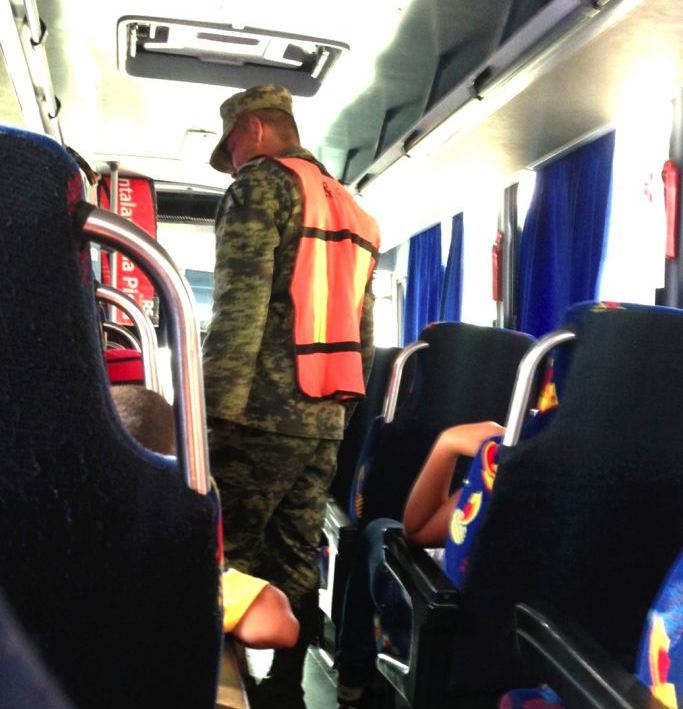
A soldier checks identifications and baggage aboard a bus in Chiapas’s Soconusco region.
Private vehicles and first-class buses often get waved through these checkpoints, but that is far from guaranteed. Police and soldiers do not enforce migration law and are not supposed to inquire about travelers’ immigration status, but occasionally do so at the checkpoints they maintain. Meanwhile, INM authorities maintain several of their own checkpoints. If authorities detect a Central American migrant without proper documentation, a bribe may allow the migrant’s trip to continue. But this is not assured, and a large portion of the Central American migrants whom Mexico deports are caught while traveling in vans and buses on the roads.
The density of checkpoints is remarkable. We encountered 11 on a 140-mile bus ride between Tapachula and Tonalá, just before Arriaga on the Pacific coastal highway. At each, at least some passengers had items inspected, had to show identification, and had to answer questions about the purpose of their travel. At the borderline we never had to show our passports; on this single bus ride, we had to show them three times.
On roads throughout the border zone, the most salient feature of the many checkpoints was an apparent lack of cooperation between Mexican security agencies with similar responsibilities. Except for the new Huixtla Customs installation, only once did we see a checkpoint being manned by more than one agency (Federal Police and INM). Instead, travelers are greeted by different agencies every few miles, with personnel reviewing the same parts of the vehicle and asking similar questions.
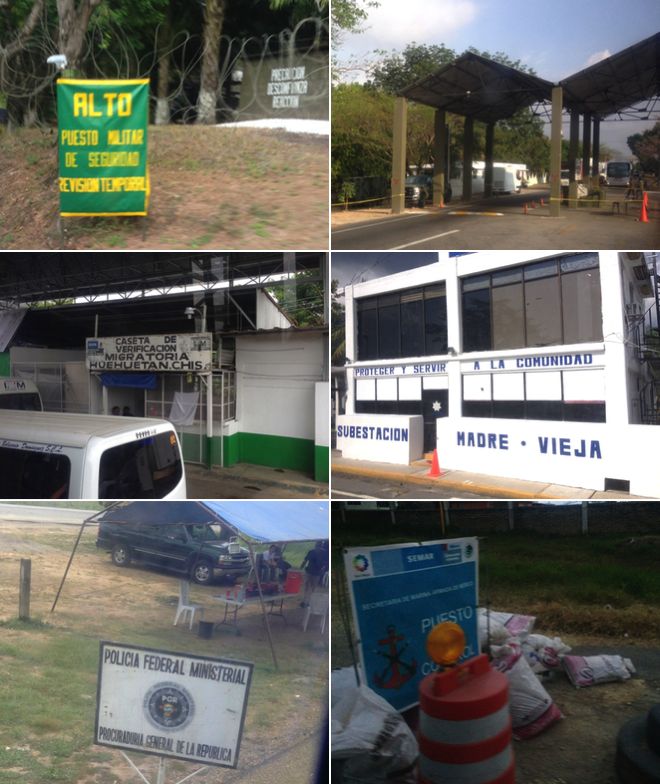
A gallery of checkpoints, clockwise from top left: Army, Army, Federal Police, Navy/Marines, Federal Ministerial Police, INM.
The agencies we encountered separately between Tapachula and Tonalá, for instance, included:

Our bus took four hours to cover this 140-mile highway distance due to the 11 checkpoints through which it had to pass.
In the remotest, emptiest part of Chiapas, the southeastern zone bordering Petén, all checkpoints were manned by the Army or Navy.
Several checkpoints had U.S. equipment on display, like mobile X-ray and other scanners—virtually all of it provided by the Mérida Initiative. U.S. assistance has also helped build facilities, particularly the large Customs complexes in Chiapas at areas where major roadways meet, about an hour’s drive from the border itself.

Mobile scanning equipment, very likely all U.S.-donated, at checkpoints in the southern border zone.
Though they are principally Customs posts, in an unusual example of interagency cooperation they also house personnel from the Defense Secretariat, the PGR, the National Assets Administration (Instituto de Administración y Avalúos de Bienes Nacionales, INDAABIN), and the National Agricultural Inspection Service (Servicio Nacional de Sanidad, Inocuidad y Calidad Agroalimentraria, SENASICA).
As of mid-2014, the Customs station at Huixtla, on the Pacific highway about 25 miles from Tapachula, is complete. Those in Palenque, in northeastern Chiapas 85 miles from the border, and La Trinitaria, in south-central Chiapas 20 miles inland, remain under construction. At the gleaming Huixtla facility, we had to disembark our bus. As our luggage passed through a scanner, we asked an official, “Is all this from Mérida [Initiative]?” He smiled and said “Yes.”

The new Customs facility in Huixtla.
One common feature of U.S. border-zone checkpoints that we did not see in Mexico was canine teams. By 2011, the Mérida Initiative had provided Mexico with 78 dogs and trained 52 canine handlers “able to detect weapons and explosives, narcotics, and bulk cash… and assigned to major ports of entry.” We observed none of these dogs during our passage through about two dozen checkpoints and visits to four official border crossings, although as of April 2014 a canine team operates at the Tapachula airport.
Especially at more rural checkpoints, security personnel tend to be very junior. Their training, which is notably uneven, is in serious need of evaluation. These facilities are far from foolproof. Most passenger vehicles are waved through or asked perfunctory questions. “¿A qué se dedica usted?” (What do you do?) is one we heard often, with no follow-up.
The security, law-enforcement, and migration presence is heavy on the roads—but as noted above, this is not so on the train lines, which see very little presence of authorities. Those who take the train face a far smaller probability of running into Mexican immigration or law enforcement personnel. This lack of protection, though, leaves them at the mercy of Central American and Mexican criminal gangs.
In response to the multiple abuses suffered by migrants in Chiapas, in 2008 the state government created a Special Prosecutor’s Office for Crimes Against Immigrants (Fiscalía Especializada en Delitos Cometidos en Contra de Inmigrantes). This is a unique office established to investigate and prosecute crimes such as extortion, human trafficking, and theft from migrants in transit and migrants residing in Chiapas. It also addresses cases of migrant women who are victims of domestic violence. When the crime is federal, the Special Prosecutor’s Office cooperates with federal authorities and provides them with the information that it has gathered as a preliminary investigation. The Office currently has offices in Ciudad Hidalgo, Tapachula, Huixtla, Arriaga, Tuxtla Gutiérrez, Comitán, and Palenque.
An interesting aspect of the Special Prosecutor’s Office is its focus on protecting migrants. It maintains a regular presence along the train route, and works with shelters and organizations to register migrants’ complaints. The special prosecutor, Alejandro Vila Chávez, reported having opened 586 preliminary investigations into crimes against migrants since the office’s creation. However, little information is available regarding how many of these investigations have ever led to sentencing those responsible for crimes against migrants.
The U.S. government has also been interested in the work of this office. Through Mérida Initiative funds, the Office has received training from the U.S. Department of Justice on the trafficking and smuggling of persons.
While large numbers of migrants pass through Guatemala’s border departments (provinces), those who come from Central America’s other three northernmost countries need not fear deportation, thanks to the Central America-4 visa arrangement. Kidnappings for ransom, extortion, and human trafficking do occur, but less frequently in Guatemala than on the Mexican side. Meanwhile, with the exception of the Petén, which is above the national average, Guatemala’s border departments have some of the country’s lowest homicide rates.
As noted above, though, Guatemala’s border zone is a heavily traveled drug-trafficking corridor. Illicit shipments, largely cocaine and methamphetamine precursors, travel the road network, arrive by boat at mangrove swamps on the coastline and, most likely, are also flown in and land on private airstrips at local ranches. Why this generates high levels of violence in Petén, but not in the other border departments of San Marcos, Huehuetenango, Quiché, or Alta Verapaz, likely has most to do with the current, fragile balances of power among local organized crime groups in each zone.
Controlling the sharply rising flow of Central American migrants in the Mexico-Guatemala border zone is a high U.S. government priority, and border security assistance to Guatemala is rising. As in Mexico, though, nearly all such assistance is delivered through aid programs established to combat drug trafficking.
Border security efforts are a large component of aid to Guatemala’s armed forces and police funded through the State Department’s International Narcotics Control and Law Enforcement (INCLE) program, delivered within the framework of a several-year aid package known as the Central American Regional Security Initiative (CARSI). One of the biggest INCLE projects was the 2013 donation of six UH-1H “Huey II” helicopters to Guatemala’s new “Inter Institutional Anti-Narcotics and Anti-Terrorist Unit,” which incorporates military and police personnel. Much additional aid for border security flows through the Defense Department’s own counter-drug interdiction budget in the framework of the Northern and Southern Commands’ “Mexico-Guatemala-Belize Border Region Program.”
Both aid programs, especially the Defense budget effort, have led a revival of assistance to Guatemala’s army. Due to serious human rights concerns, since 1990 U.S. law has prohibited delivery of assistance to the Guatemalan Army through the annual foreign assistance budget. (In 2005, though, the Bush administration delivered some 1980s aid frozen in 1990, and the 2014 foreign aid law softens the ban to a set of conditions that Guatemala has yet to meet.)
The Defense Department, though, is not subject to these restrictions. The Pentagon can use its budget to provide similar foreign aid if “support for counter-drug activities” is its main purpose. Guatemala’s security forces received US$27.5 million in Defense budget aid between 2008 and 2012. A large portion—we do not have an exact figure—has gone to Guatemala’s army.
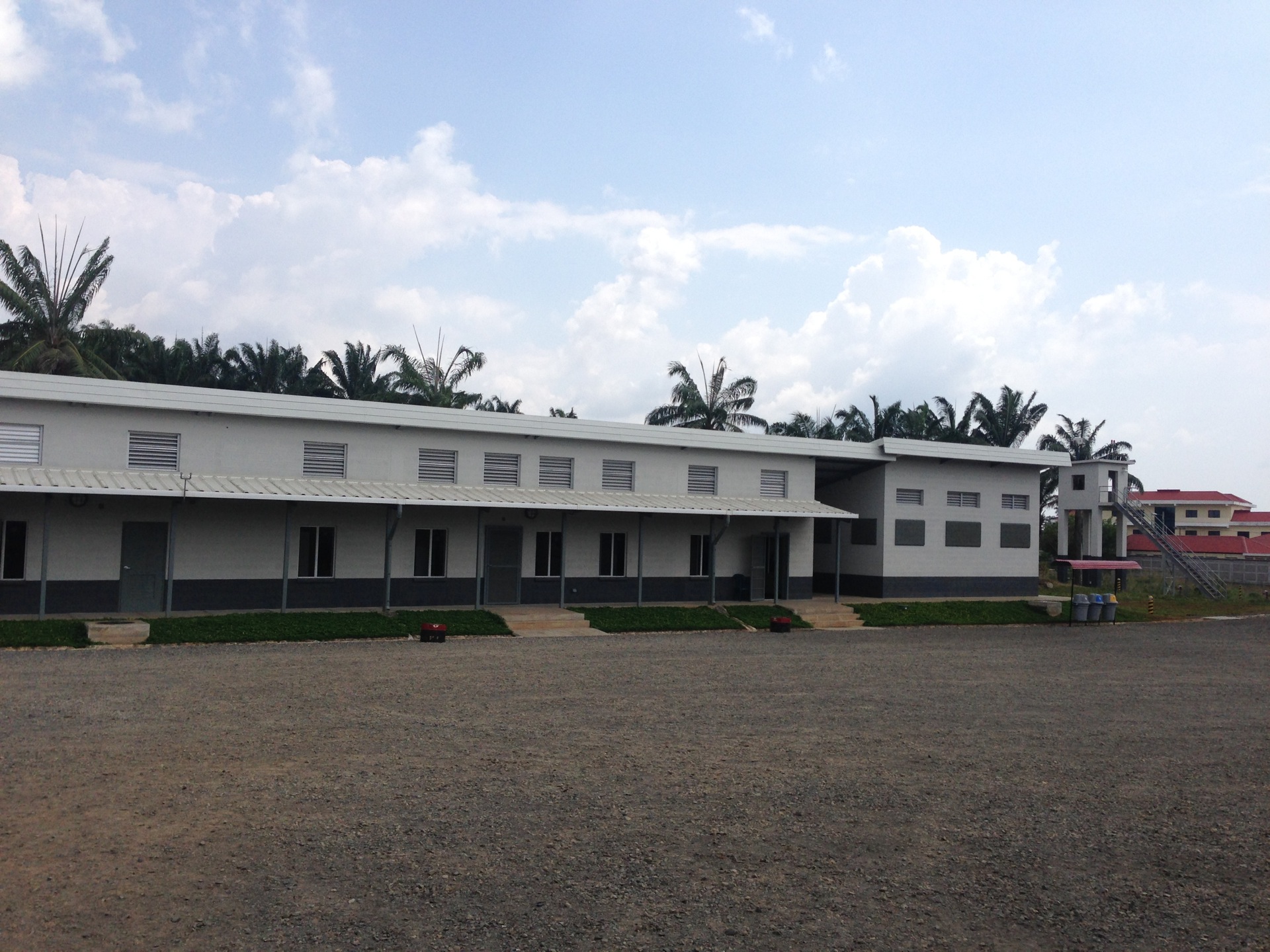
The newly built Joint Task Force Tecún Umán facility in Tecún Umán, Guatemala.
The largest U.S. military aid initiative has been the creation of an army-police-customs joint task force, known as “Tecún Umán,” which operates in Guatemala’s far southwest border zone. It is headquartered in the city of Coatepeque, Quetzaltenango, about 20 miles from the border, and maintains forward bases near the border, including the town of Tecún Umán.
After a period of training and facilities construction, Tecún Umán has been operational since mid-2013. While its actual personnel strength is secret, it is roughly battalion-sized, and thus likely somewhere between 500 and 1,000 members. They are mostly soldiers, but this “joint” or “inter-institutional” unit also includes police and prosecutors.
The unit’s members have received armored vehicles, facilities construction, training, and other support from the U.S. Defense budget. “More or less everything you see here was paid for by the United States,” a Guatemalan Army official at the Tecún Umán base told us. The unit’s facilities have a very American feel, as they were built by Salvadoran contractors according to a Southern Command-provided design. The exit signs even say “EXIT” instead of “SALIDA.”
The Joint Task Force potentially represents a big new internal role for the Guatemalan military: public security in border zones. Officials are quick to point out that this is a joint unit combining both army and police personnel, and that when an operation involves policing work, the soldiers’ role is to support the police, who are out front and interacting with civilians. (During our trip, we passed through a Joint Task Force checkpoint. It had police personnel out front, and soldiers positioned conspicuously but a few yards back, along the roadside.)
Still, human rights defenders worry about a new mission that increases contact between the population and the Guatemalan Army, which has never been held to account for large-scale human rights violations committed during the civil war that ended in 1996. Judicial efforts to do so have sputtered since the 2013 overturning of a genocide sentence against ex-dictator Gen. Efraín Ríos Montt.
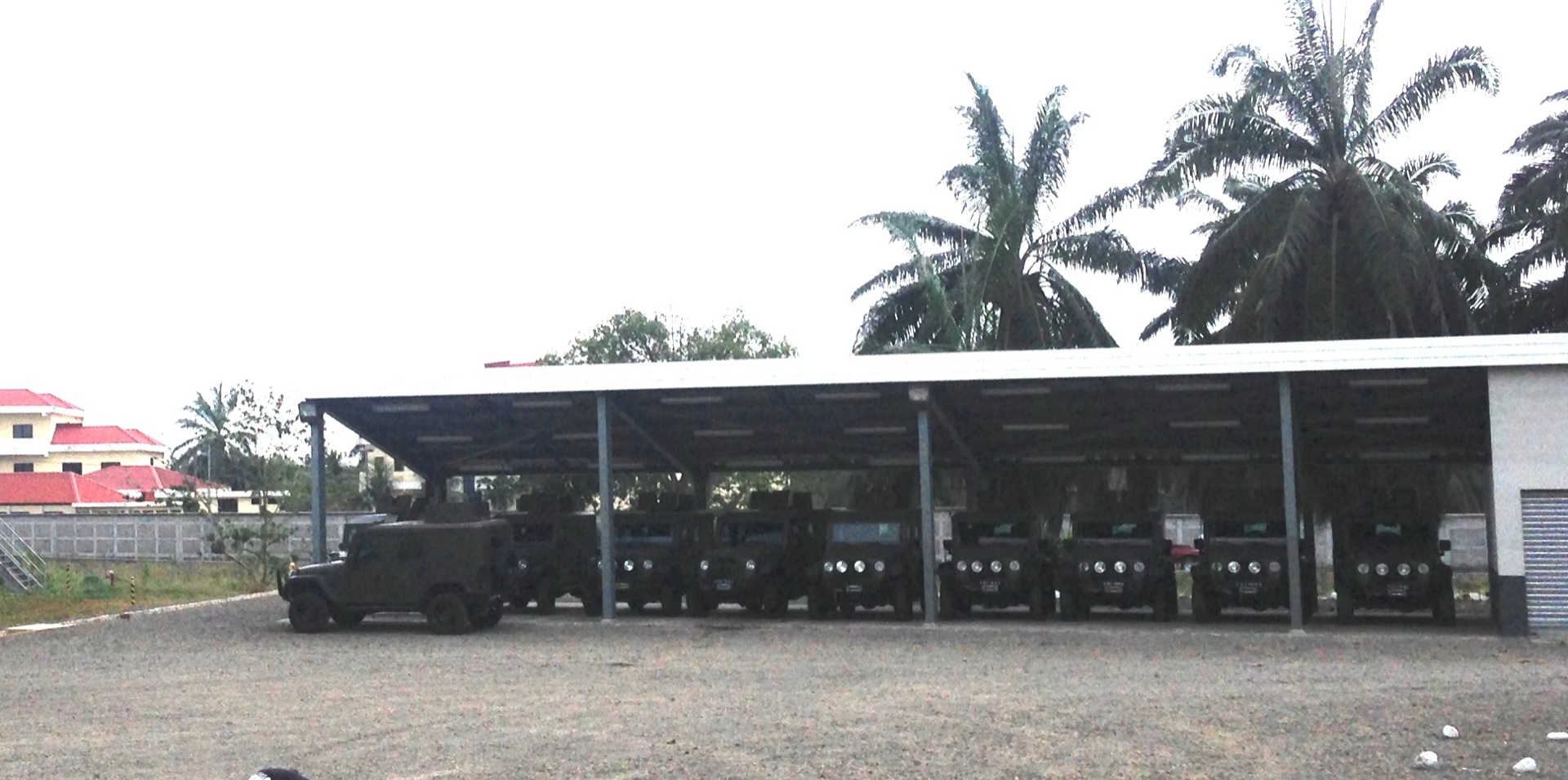
U.S.-supplied vehicles at the Joint Task Force Tecún Umán facility in Tecún Umán, Guatemala.
During the 2000s, Guatemala did make some progress toward reducing the armed forces’ size and role, and increasing civilian control of security budgeting and policymaking. The creation of a new army unit with internal security responsibilities, then, seems like a retreat from the tentative progress Guatemala’s civil-military relations had been making.
As of February, the new task force had few concrete results to report in terms of drug seizures or high-profile arrests. In July-October 2013, though, elements participated in “Operation Dignity,” a joint military-police effort against a narcotrafficking organization in Huehuetenango. Though migrants continue to stream across the border, interdicting them is not a mission for the task force—it may detain them, however, if it finds any during an operation who are in violation of their CA-4 visa terms, or who are from outside the region. It is not clear how often this happens.
Though the Tecún Umán task force still gets much U.S. training—a contingent of U.S. National Guard from Georgia was in the country for an extended training deployment in early 2014—most U.S. aid to the unit has been drawn down since the initial setup. Maintaining vehicles and equipment, paying for gas and supplies, and similar services are now mostly funded through Guatemala’s treasury.
Defense Department military and police aid continues elsewhere, though, as the Joint Task Force model expands in Guatemala. By the second half of 2014, Guatemala expects to launch Joint Task Force Chortí, which will operate along the country’s border with Honduras.
During our field research in Chiapas and Tabasco, WOLA staff met with local community organizations, human rights organizations, academics, and other experts to get their views on the security situation in the state, and whether they have perceived any significant changes in the state and federal governments’ efforts to secure the southern border. These impressions varied depending on their location, but in general we heard concerns in several areas.
A common finding from these interviews, as well as in our reviews of official documents and press coverage, is opacity. Mexican authorities are reluctant to divulge information about current and impending programs, or even to acknowledge that a large-scale border security effort is underway. INM officials denied the existence of border security measures. Yet on the day of our interview with these officials in Mexico City, a delegation of INM personnel was visiting the southern border with counterparts from the U.S. Drug Enforcement Administration (DEA), Federal Bureau of Investigation (FBI), and the Guatemalan National Police.
This lack of transparency has been highlighted by Mexico’s Federal Institute for Information Access and Data Protection (Instituto Federal de Acceso a la Información y Protección de Datos, IFAI—similar to the Freedom of Information Act process in the United States). In an individual response to a request for information from INM on its “Southern Border Plan” or similar document, the INM affirmed that it did not have any information. The IFAI appealed, affirming that in fact the INM had worked on a “Program of Migration for Mexico’s Southern Border” together with national and international public officials, academics, civil society organizations and the private sector. In April 2014, the IFAI ordered the INM to do an exhaustive search in all of its departments for any documentation of this plan and the INM’s role in it.

Remains of a campfire by the tracks in Lechería.
Although migration should not be directly linked to national security, we gained some information regarding the southern border plan from the Coordination Office of the Southeast, part of the National Security Commission. As noted above, this office views the underlying framework for Mexico’s southern border as “security for development” and “development for security.” The program’s economic component seeks to exploit the area’s natural resources, which it claims would complement efforts to guarantee security for investments in the area, thus contributing to productivity and safety.
Migration is an aspect of this strategy, as migrant flows may be used for labor, particularly in agricultural sectors like banana and oil palm plantations. The government aims to establish five “poles of economic development” in the border states: Marqués de Comillas and Tapachula, in Chiapas; Candelaria, Campeche; Tenosique, Tabasco; and Chetumal, Quintana Roo.
Another sign of development in the region was the opening of a new international airport in Palenque, Chiapas, on February 14. The airport is meant to facilitate the expansion of tourism, along with state and federal plans to expand and improve the highway between Palenque and San Cristóbal, whose 133 miles can take up to five hours to traverse given the road conditions and dozens of speed bumps.
These and other large development projects in this resource-rich region (such as gold mines and hydraulic and wind energy projects) have residents feeling anxious. Local residents, particularly indigenous communities, have rarely been consulted about them, and very little public information exists about the government’s future plans.
Especially in Chiapas, residents also had misgivings about the increased presence of federal security agents in the state. Many have experienced violent repression against their organizing and advocacy in the recent past. We repeatedly heard a view that new security forces were being stationed in the state for reasons other than to seize drugs and weapons or to detain migrants. Human rights defenders and community groups speculated that the positioning of security forces may owe more to preparations to respond to potential social conflicts as development projects are put into place, mines are opened, and highways are built or expanded through communities.
If Mexico guides its southern border development according to the priorities of the business sector and border security, the impact on migrants’ and residents’ human rights could be severe. There are many risks of expanding security and migration agents’ presence while controls over their actions remain weak.
This was made plain by an April 2014 operation that led to the detention of 300 Central American migrants who were stranded in Tenosique, Tabasco, after the train company stopped allowing them to use the train to travel north. They decided to walk north as a group; after about 25 miles they were stopped by an INM-led operation carried out in collaboration with the Federal Police and some state and municipal police. During the raid, security agents beat many of the migrants, as well as Fray Tomás González and other workers from the shelter in Tenosique who attempted to intervene to protect the migrants. During their transfer to the detention center in Tapachula, the migrants were not given food, water, or medical attention. All were deported shortly afterward with no opportunity to lodge a formal complaint about the abuses they suffered. One Honduran woman and her son stayed longer due to her health (she fainted during the raid); the Fray Matías de Córdova Human Rights Center put her in touch with the Secretariat of the Interior’s Refugee Assistance Commission (Comisión Mexicana de Ayuda a Refugiados, COMAR) to request refugee protection, but both were deported without the request being processed.
The INM ranked eighth in the number of complaints of human rights violations received by Mexico’s National Human Rights Ombudsman (Comisión Nacional de Derechos Humanos, CNDH) between January and April 2014. The federal security forces—both the police and the military—rank even higher. Complaints of abuse by the INM are particularly prevalent in Chiapas and Veracruz. An assessment of the INM by the non-governmental Democracy and Security Institute (INSYDE) found severe structural weaknesses that call into question its capacity to implement Mexico’s migration laws and protect the rights of migrants in transit.
The sensation of public insecurity in the border zone stems in large part from the mere presence of so many security personnel. These forces’ official language justifies detentions of migrants, which they call “rescues,” as measures to protect the migrants’ own security. Migrants are “rescued” by security agencies on a continual basis in Chiapas, as in other states in Mexico. The use of the term “rescued” is troublesome, as in most cases the migrants were neither victims nor being held against their will. In one March 2014 case in Reynosa, in the northern Mexican border state of Tamaulipas, a group of migrants who had been “rescued” by the military received no attention to ascertain whether they had been victims of a crime, nor were they transferred to the INM. The military simply left the migrants out on the street, and a criminal group subsequently kidnapped ten of them right outside the city’s migrant shelter.
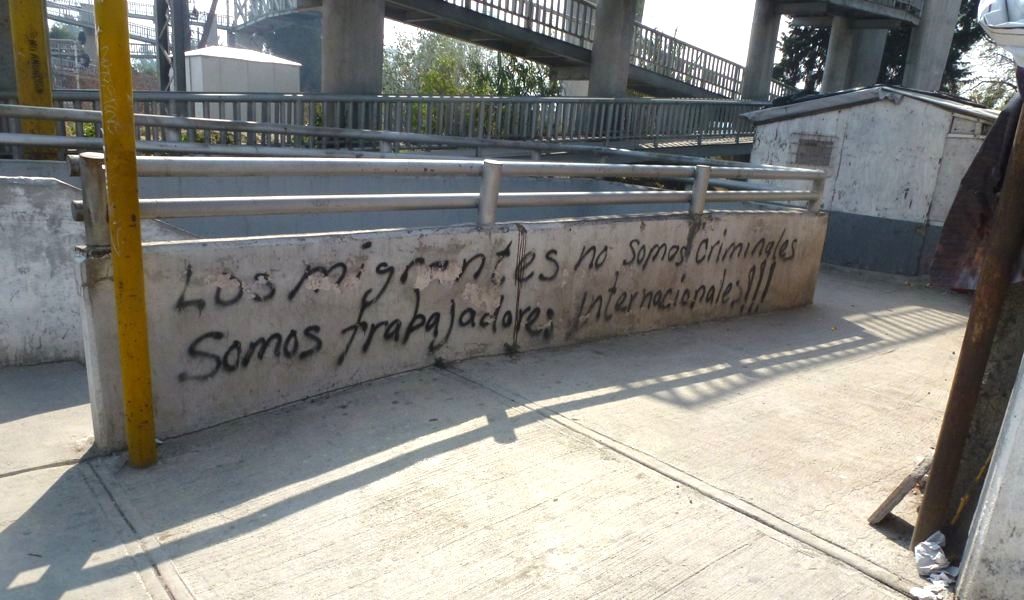 “We migrants aren’t criminals, we’re international workers,” reads graffiti in Lechería.
“We migrants aren’t criminals, we’re international workers,” reads graffiti in Lechería.
In another case from late April 2014, personnel from the Chiapas State Attorney General’s Office, the INM, the state Public Security Secretariat, and municipal police stopped a van traveling along the highway between Palenque and Benemérito de las Americas in northeast Chiapas. The authorities detained two smugglers from Honduras and Mexico who had been paid US$500 per migrant to cross them into Chiapas and take them to the U.S. border. Authorities did not report on what happened to the “rescued” migrants, although on other occasions they have been turned over to the INM for lack of a legal permit to be in the country. In these occasions, the term “rescued” appears to be a friendlier way to say “detained and deported.”
Given the possibility of more human rights violations, an increase in federal security forces would likely worsen the situation for local communities. In the Pacific coast area of Chiapas, residents spoke of the increased presence of Federal Police and Marines. They told of soldiers often stopping people and asking for identification or their car registrations, even though they have no legal basis do to so. Communities also cite social implications of the presence of more security agents, such as an increase in prostitution and more incidents involving the use of drugs and alcohol.
Their misgivings about federal security agents are compounded by widespread distrust of municipal police. Residents complained of corruption within the force, including local police agents’ extortion of local shops. The Digna Ochoa Human Rights Center, based in Tonalá, registered three cases of torture by municipal police in the city in 2013. Torture by municipal and investigative police continues to be a problem in other parts of the state. Indeed, just days before our visit, the Fray Bartolomé de las Casas Human Rights Center denounced the detention and torture of two indigenous men by municipal police in a neighborhood of San Cristobal de las Casas.
Division and overlap of police forces’ roles appears to present yet another set of problems. Throughout Chiapas, civil society representatives expressed concern about the increased role of federal security forces in everyday public security tasks that should correspond to state or municipal police. For their part, they lamented municipal police forces’ greater focus on combating organized criminal activity, at the expense of crime prevention and community policing.
Although many migrants have credible claims to qualify for refugee status, as noted above the COMAR only approves a small number of requests each year. The Mexican government may in fact be moving away from its longstanding practice of providing humanitarian visas to individuals fleeing from violence and persecution. COMAR reported that it had received 4,589 refugee status requests between 2009 and 2013, but had approved only 24.7 percent. Requests increased over 90 percent during this same period; four out of ten were from El Salvador and Honduras.

The low acceptance rate is in part due to legal obstacles, among them that migrants can only file a claim within 30 days of entering the country. In addition, migrant rights groups criticize COMAR agents’ effectiveness in assessing claims. Agents often conduct only minimal research on conditions in refugees’ countries of origin, and rarely have qualified interpreters on hand during proceedings. Many interviews with migrant applicants take place only by telephone. The arguments used to reject claims often follow a predetermined format, without justifications that would correspond to the cases in question.
Apart from Latin Americans, staff at the Fray Matías de Córdova Human Rights Center in Tapachula reported having worked on refugee status requests for individuals from Nigeria, Cameroon, Ghana, India, and Nepal, illustrating the diversity of migrants who travel through southern Mexico.
Many migrants are discouraged from applying for asylum, or end up dropping their claims, because they face a long period of detention in an INM “migration station” while their claims are being processed. The INM’s Siglo XXI detention center in Tapachula is the largest such facility in Latin America, with a capacity to hold 990 migrants. The INM maintains 22 migration stations throughout Mexico, in addition to smaller posts.

The “Siglo XXI” INM detention facility in Tapachula.
Migrants in detention often complain about poor conditions, mistreatment, and abuse. One Honduran migrant who spent three months in the Siglo XXI center told us that he had to sleep on the floor with no blankets, that the food was insufficient, and that he had to fight or pay for everything, including soap. In its documentation of the conditions in this detention facility, the Fray Matías de Córdova Human Rights Center has raised concerns about lack of access to health and psychological services, and a failure to provide adequate space for families and visitors. Authorities rarely give migrants clear information regarding the length of their stay in the detention center or about the deportation process itself. In legal proceedings, meanwhile, migrants are rarely provided with adequate representation and interpretation services, and Central American governments often fail to provide adequate consular services.
Human rights organizations that provide legal assistance to these migrants, like the Fray Matías Center, face many obstacles. Center staff are only allowed into the Siglo XXI facility two days a week, for an hour-long visit. They are not able to enter the area where migrants are housed, since interviews are held in a specified office. They can only speak to migrants who are on a list that they have previously provided to the INM.
Communities between Tapachula and Arriaga, along the Pacific coastal highway passing through Chiapas’s Soconusco region, appeared to have seen the largest recent increase in security agents’ presence. As described above, there are currently eleven checkpoints between these cities, manned by a variety of agencies. For residents of towns and communities along this route, what used to be a one-to-two-hour trip to see the doctor or run errands in Tapachula now can take anywhere from three to four hours.
Although some residents reported unpleasant exchanges at checkpoints and commented on agents’ frequent arrogant behavior, we did not hear about reported incidents of excessive abuse. However, it was also clear that these communities were just coming to terms with this expanded number of checkpoints. Some residents expressed alarm at these multiple stops becoming the “new normal” for the area.
Other areas of Chiapas have not experienced the same dramatic increase in checkpoints as the coastal area. Still, members of civil society organizations in San Cristóbal de las Casas, Comitán, and border towns around Ciudad Cuauhtémoc expressed similar concerns about abuse and harassment at checkpoints—including at Army checkpoints that have been in place since the 1994 Zapatista uprising. Unlike the coastal region, two of the Army checkpoints between Benemérito de las Américas and Palenque required all passengers to dismount from their vehicles, which are searched while passengers are questioned about the purpose of their travel. Between Comitán and Palenque, on the long, empty road that follows the border with Huehuetenango, Quiché, Alta Verapaz, and Petén, soldiers at every checkpoint asked us the purpose of our visit. While our trip was uneventful, members of civil society organizations reported more cases of abuse at these checkpoints, calling them retenes duros (hard checkpoints).
Migration enforcement in Mexico is a federal government responsibility. The competent authority for basic functions, like verifying individuals’ migration status and detaining undocumented migrants, is the INM. Mexico’s Migration Law makes clear that the Federal Police are the only other agency that can support and coordinate with the INM in activities to control migration. Inter-institutional accords also exist for transferring migrants and attending to migrants who have been victims of crime in Mexico.
Still, the reality is more complicated as migration and security missions overlap strongly, creating coordination challenges among migration, law enforcement, prosecutorial, and military bodies.
An example in Chiapas is the state Border Police force, whose responsibilities overlap with other forces at several levels of government. The previous governor, Juan Sabines, created the 135-member Border Police as a force within the Secretariat of Public Security of Chiapas. Its mission is to patrol and prevent crime in Chiapas’s border area, which encompasses 17 municipalities. However the new governor, Manuel Velasco, has created a new elite state police force, the Citizen Power Police (Policía Fuerza Ciudadana), which also has a significant role in border security. Of the 400-plus officers in the new force, around half are being deployed to patrol the border region to prevent crime. Following the trend to militarize public security in Mexico, these agents have also received training from Mexico’s army and navy. News reports suggest that both forces—the Border Police and the Citizen Power Police—are now operating in the border region of the state and participating in joint operations, including a recent case in which both forces detained a group of Hondurans trying to extort migrants in Palenque.
 Customs and Army officials at the recently built Huixtla Customs facility.
Customs and Army officials at the recently built Huixtla Customs facility.
Another example is Operation Soconusco II, a joint operation of SEDENA, SEMAR, Federal Police, INM, and state and municipal police, as part of a strategy to combat human trafficking, smuggling, and other crimes in the Chiapas coastal border region. Through this operation, from mid-January to mid-February, the INM “rescued” 1,438 migrants while the military detained 74 people (70 Mexicans, 3 Guatemalans and a Salvadoran) for such crimes as human trafficking, human smuggling, and drug trafficking. Operation Soconusco is carried out within the framework of Bases Operativos Mixtos (Mixed Operation Bases), inter-agency efforts among all three levels of government for security along the border.
Although state and federal government officials speak frequently of increased coordination, apart from specific joint operations, this coordination is not yet common on the ground. As noted above, a key inter-agency failure was plainly on display at the numerous checkpoints through which we passed in Chiapas. Almost none of them were manned jointly, and the result was that it was rare to pass ten miles without encountering a different agency’s separate roadblock. At one checkpoint, a soldier searched the bus in which we were traveling for drugs; at another checkpoint a Chiapas state police officer searched the same part of the bus, presumably also looking for drugs or other contraband.
This remarkable variety of security agencies is in part due to the distinct institutional mandates of each agency: only the INM, with Federal Police support, can enforce migration law. The military, Federal Police, and Federal Ministerial Police are primarily tasked with combatting such federal crimes as drug and arms trafficking and organized crime, while state and municipal agencies have primary jurisdiction over common crime. However, in the context of the Mexican government’s efforts to combat organized crime, the roles of federal, state and municipal agencies have been blurred. The evident duplication among the many checkpoints seemed to indicate a lack of cooperation—if not outright distrust—between the numerous security and law enforcement agencies operating in Mexico’s southern border zone.
The Peña Nieto government’s “belts of control” proposal appears to recognize this issue. According to news coverage, National Security Council officials foresee “the integration of mixed security cells, with agents of the three levels of government [federal, state, and municipal], so that they may watch over each other and denounce corruption from within.”
The involvement of military forces in border security, or in citizen security in border zones, raises concerns about what some local organizations called “militarization,” defined as the armed forces’ performance of functions that should fall within the security responsibilities of civilians. There are many long-term dangers to involving the military in internal security or policing roles. Military training and tactics are often at odds with what is needed for effective policing; soldiers are trained to use the maximum force necessary to combat enemies, not to deter or investigate crimes, or to interact with and directly serve the population. When military training is applied in public security activities, abuses are likely to occur This has been clear in Mexico’s case; complaints of human rights violations by the armed forces received by the CNDH have increased fivefold since former President Calderón deployed the military in operations to combat organized crime in December 2006 (rising from 213 complaints in 2006 to 1,196 in 2013).
Despite the increased presence of federal security agents, no resident of the border area with whom we spoke voiced the opinion that the drug trade has been significantly affected. Planes continue to land and boats continue to come ashore, and drugs are offloaded with little challenge from the authorities. Despite the region’s notoriety as one of the world’s principal cocaine trafficking routes, authorities seize very little, whether in the border zone or elsewhere in Mexico. The 3.7 tons of cocaine interdicted throughout Mexican territory between December 2012 and July 2013 was less than half the full-year seizure totals reported by Bolivia, Brazil, Colombia, Costa Rica, the Dominican Republic, Ecuador, Panama, and Venezuela.
Instead, several activists, experts, and citizens coincided in speculating that authorities seem more intent on detecting Central American migrants, whom they can easily extort, than criminal activity. And indeed, the statistics (cited above) indicate that migrant detentions and deportations are far more robust than drug seizures in the southern border area.
Our study of, and travel to, the Mexico-Guatemala border zone have left us with a complicated picture.
A rapidly growing migrant population and a large volume of illegal goods cross the border easily. Inland border security measures rely on relatively uncoordinated security forces with serious human rights, corruption, and trust issues. These forces stop few illegal goods in the southern border region, and end up channeling migrants toward the train network and other dangerous routes where they fall prey to organized crime; at times they also abuse and extort migrants themselves.
This broken policy is contributing to one of the most severe humanitarian crises in the Western Hemisphere. As one migrant recently told a U.S. journalist, “When you live in Honduras, you quickly learn that anywhere and anything is better, but then you get to Mexico and you understand that hell extends beyond Honduras.”
A new border security approach will do more harm than good if it reinforces these existing incentives, and if—with new equipment, technology, training, and manpower—it strengthens troubled, unreformed institutions. Migrants will also continue to be easy prey for criminal groups as long as the Mexican government fails to investigate and prosecute those who commit crimes against them, or to protect those who assist this vulnerable population.
A better approach would require some profound changes and reforms. The trouble, though, is that most of these changes are hard to implement and long-term in nature. There is little doubt that security at Mexico’s southern border, and migrants’ humanitarian situation, would ease enormously if governments took four steps.
“What needs to be done,” then, is either politically unlikely or will take a generation to implement. As a result, it may be tempting for the Mexican, Guatemalan, and U.S. governments to intensify some of the “hard” security measures we saw coming online during our visit to the border zone. More checkpoints and deployments, more technology and patrols, more detention centers and more use of regular military forces. These, however, will not resolve a situation that is fed by poverty, weak legality, rampant corruption, and high tolerance of organized crime. They could, in fact, exacerbate it.
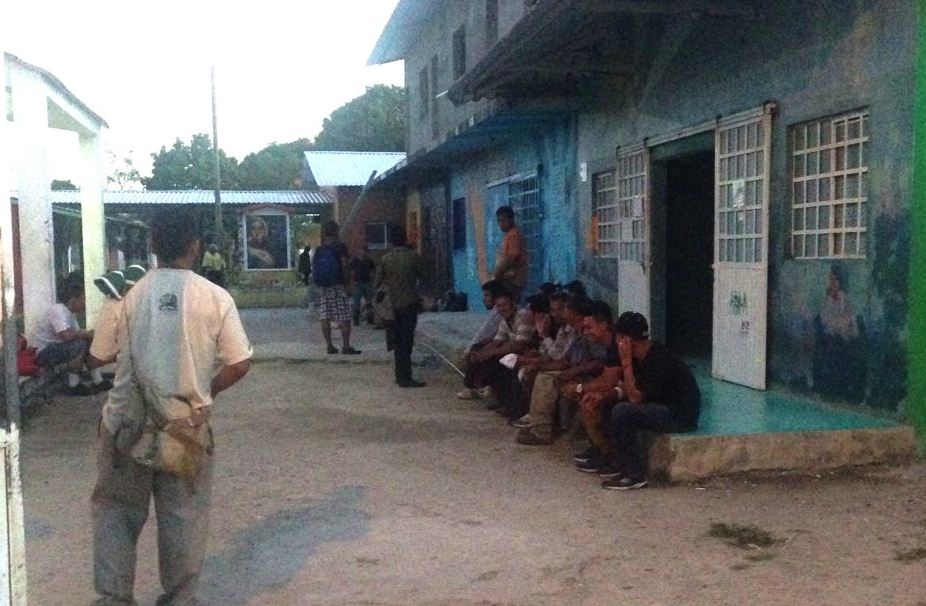
The “La 72” shelter in Tenosique.
What can be done instead, then, to make the Mexico-Guatemala border more secure and to ease the mass migration crisis? Some near-term options exist. They will not resolve the situation, but they can at least help to mitigate the abuses and begin to address the crisis of border security and migration. We recommend the following measures and principles.
This report could never have been produced without support from many people and organizations that were very generous with their time and, in some cases, their resources. WOLA wishes to thank:
And the staffs of:
WOLA offers particular thanks to the Ford Foundation for its financial support and excellent advice.